Boat Profile
A little camp cruiser for big dreams
From Issue Small Boats Annual 2016 October 2015
N ever mind that until grounding on a mudflat less than 30 miles from the finish line, SCAMP #4 breezed through a difficult year in the 300-mile Everglades Challenge adventure race a few years ago, pressing on comfortably when many bigger boats had to quit. Never mind that during the inaugural Race to Alaska earlier this year, SCAMP #11 completed a very rough 40-mile open-water crossing of the Strait of Juan de Fuca, taking its solo skipper safely from Port Townsend, Washington, to Victoria, British Columbia. And never mind that yet another SCAMP (extensively modified for the venture by its builder) may attempt to round Cape Horn—yes, that Cape Horn—this year and, if successful, will be the smallest sailboat ever to do so. Despite all that, the overwhelming impression I get when Dave Ender drives up with his newly built SCAMP to take me sailing is: What a cute little boat.
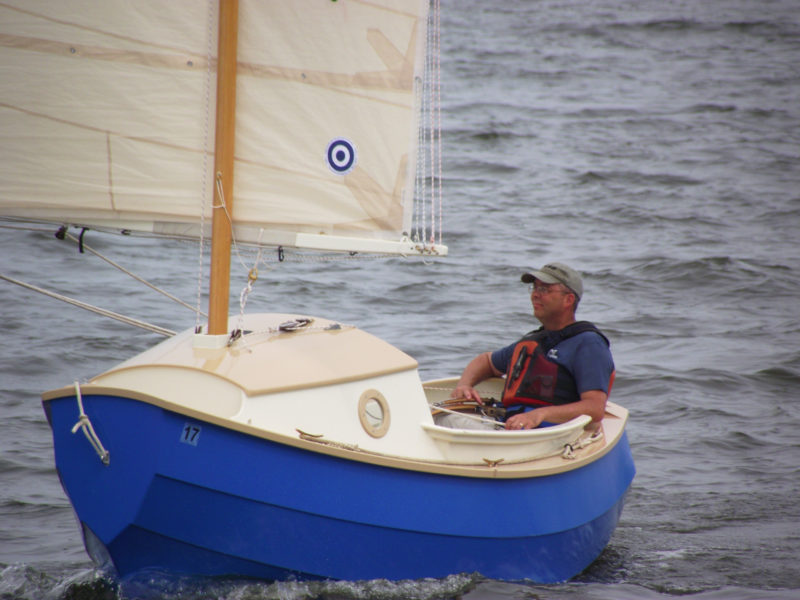
The buoyancy of the blunt pram bow resists digging in while running downwind and reduces the likelihood of broaching.
SCAMP is short, curvy, beamy, and high-sided, with a well-rockered flat bottom and a distinctive pram bow—a cross between a bulldog, a basketball, and an angry rubber duck. It’s also one of the easiest-launching boats I’ve ever encountered. I barely had time to grab my gear before Ender had the boat rigged and ready: mast stepped, sail hoisted, and rudder hung on the transom. He backed the trailer into the water and shoved SCAMP off. Less than 10 minutes from arrival and it was time to sail.
Josh Colvin, who commissioned SCAMP—an acronym for Small Craft Advisor Magazine Project—wasn’t looking for an ultimate adventure boat when he approached New Zealand designer John Welsford (see WB No. 225 for a profile on Welsford and his design work). “My initial goals for the boat were based largely on a 150-mile sail down the Columbia River, from Beacon Rock to Astoria,” Colvin says. “I kept coming across backwaters and shallow estuarine areas and thinking, That’s where I really want to go , but my 16-footer was too deep, wasn’t easy to row, and if I wanted to overnight up among the reeds, wouldn’t dry out level if the tide left. So the idea I eventually took to John Welsford was for the smallest possible boat that would be able to do all of these things, but still be seaworthy enough to cope with something like the middle of the Columbia River on a breezy afternoon.”
Judging by SCAMP’s popularity among amateur builders—roughly 340 kits or plan sets have been sold since 2011, with about 60 boats launched—plenty of other people are interested, too. Designer John Welsford sees SCAMP as a sort of 21st-century version of a much-loved classic, the Mirror dinghy. “While we don’t expect to do anywhere near as many boats,” Welsford says, “it’s hitting a similar, but older market.” Along the way, SCAMP has fostered an enthusiastic and supportive community of builders and owners, encouraging new builders to take the plunge.
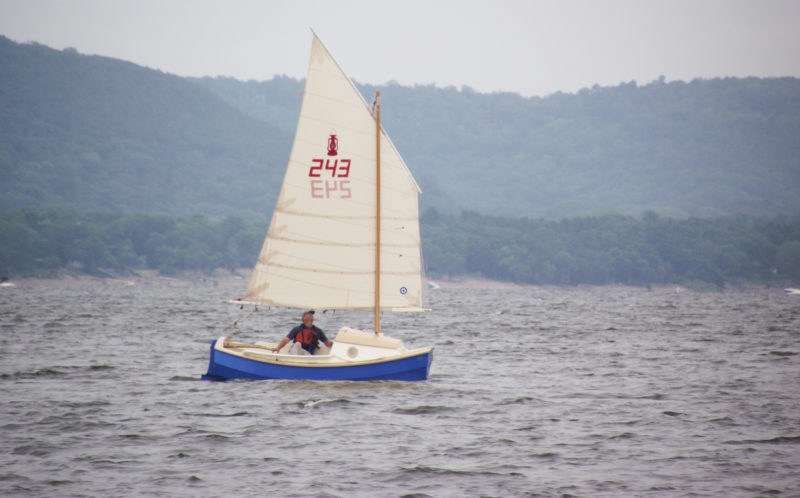
The SCAMPS’s 100-sq-ft sail is set high for good visibility under the boom and is easily reefed.
To bring the new design to life, Welsford was able to make good use of his previous experimentation with similar boats. “SCAMP is number six in a series of very beamy, shallow-bodied boats with that distinctive high-positioned pram bow,” Welsford says. “Tender Behind, Tread Lightly, and Sherpa are the other designs that made it to plans. All work really well, can carry huge loads for their size, sail well, and are well balanced. I learned something from each of them, and SCAMP is a result of that learning.” Besides Welsford, boatbuilder/designer Kees Prins of Port Townsend, Brandon Davis of Turnpoint Design , and adventurer/prototype tester Howard Rice all contributed to final design details and kit elements for SCAMP.
SCAMP is built upright on its flat bottom, which serves as the base for an egg-crate arrangement of plywood that forms the boat’s furniture and structural members. No temporary molds or frames are used. It’s a method that makes for an exceptionally stiff hull, and a safe one—the completed “boxes” create six entirely separate buoyancy chambers within the glued-plywood lapstrake hull. Welsford reports that one SCAMP was able to remain comfortably afloat despite suffering “a hole in the side that you could put your head through” after hitting a snag. And although there are plenty of parts to assemble when building a SCAMP, no single step requires more than moderate woodworking skills and a selection of basic tools.
S CAMP is rigged with a single balanced lugsail, an excellent choice for a cruising rig that’s simple to handle and easy to reef. With 100 sq ft of sail and the stability to stand up to it, the boat also performs well. On my second sail in a SCAMP, working to windward on a gusty day, I was able to keep ahead of a 21′ Sea Pearl for several miles. SCAMP’s shallow draft and flat bottom make it a perfect gunkholer, and 173 lbs of water ballast (roughly 40 percent of the total hull weight) make it capable of much more. It’s no pulling boat, but SCAMP won’t be too difficult to move under oars when necessary. Some builders have considered experimenting with a single sculling oar at the transom; Dave Ender plans to try a yuloh. There’s room to mount a small outboard on the transom for backup propulsion.
Builders have the choice of building from plans or from a kit, with custom sails and hardware available for purchase. Another popular option for builders is the SCAMP Camp , a two-week intensive class in which participants come together to assemble their own SCAMP kits under the direction of designer John Welsford and prototype tester Howard Rice.
One unintended feature of the design deserves mention: several SCAMP builders I have met describe the boat as “a chick magnet,” and from my own observations at various messabouts and festivals, I’d say that such a claim is closer to reality than to hype. For potential builders with wives or girlfriends reluctant to take up sailing, this might be the single biggest advantage SCAMP has to offer.
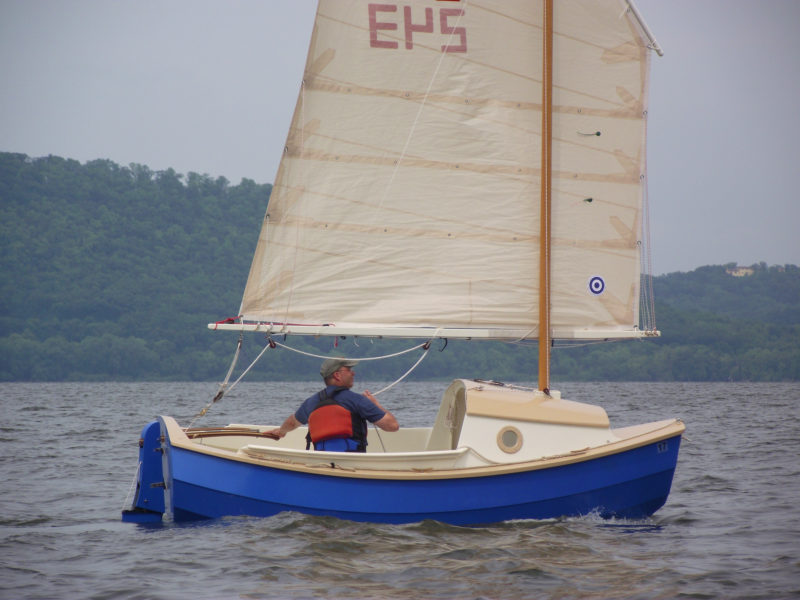
A kick-up rudder allows sailing in shallow water and twin skegs help the SCAMP sit solidly upright when grounded.
B ack aboard Dave Ender’s Scamp, we were away from the dock with an easy shove, heading across Lake Pepin, a wide stretch of the Mississippi that’s often subject to strong winds sweeping down between tall bluffs. Dave filled the ballast tank under the cockpit sole. With the drain holes open, the tank floods itself almost completely; the top of the tank is a few inches above the waterline, so must be topped off by replacing the plugs and pouring water in with a bucket from the cockpit before sealing. He could pour water in quickly without worrying about spilling or overflowing: The excess water drains out of the cockpit’s scuppers. With the water ballast in, we soon shook out the reef we started with, and Dave put me at the tiller. It was a windy day, but even under full sail we continued on in perfect comfort. SCAMP may be a small boat, but it’s the biggest small boat I’ve ever sailed. In fact, it’s almost impossible to categorize SCAMP by size. It weighs just over 400 lbs empty, but has the cockpit and freeboard of a 20′ keelboat (in fact, the freeboard is so high that reboarding the boat without a pre-rigged foot stirrup or rudder step would be problematic). It’s easy to drag up a SCAMP onto a beach for a quick stop ashore, yet filling the ballast tank adds stability well beyond the reach of a typical small boat. The self-draining cockpit sits high enough above the water that you feel like you’re aboard a much bigger boat—yet SCAMP is extremely maneuverable, tacking easily and spinning around within its own length like the smallest dinghy.
While it performs well enough to keep experienced sailors interested—Dave and I kept pace with several much bigger keelboats without much trouble—SCAMP would also be a great boat for beginners to learn on. The balanced lug makes tacking or jibing very simple and stress-free; lazyjacks hold the sail and boom securely in place, making reefing easy once the lines and cleats are set up; the boat is stable and comfortable. And it’s pure fun to sail. The only thing that I needed some time to get used to was being so far from the water compared to the sail-and-oar boats I usually sail. Of course, that higher freeboard and greater volume help make it easy to recover from a capsize (see the video below). By the time Dave and I returned to the dock, I was reminded again of just how much I like this design, and how much it can do.
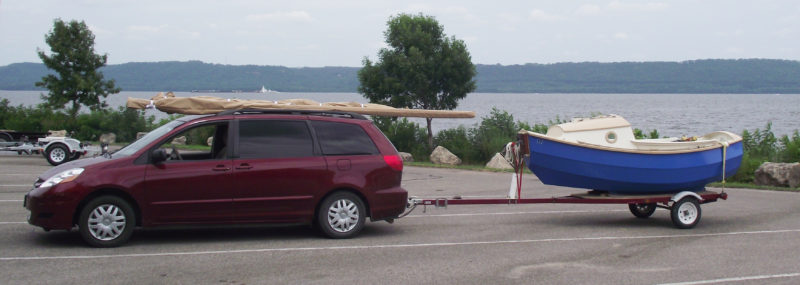
The diminutive SCAMP is easily trailered, rigged, and launched.
With its quick launching capabilities, SCAMP would work well as a family-friendly daysailer. There is space enough for four adults in relative comfort (three is better; two is luxurious), and the boat’s stability makes it a comfortable ride even for the elderly and infirm, young children, or passengers who might simply be a bit nervous around boats. The boom is high overhead, minimizing the risk of hitting an inexperienced passenger, and the seats are wide and comfortable.
Cruising solo or two-up is where SCAMP really shines. The 8′3″ x 29″ cockpit sole provides ample space for one person to sleep aboard very comfortably (the offset centerboard is hidden in the starboard seat face), and filler planks between seats can be used to create a double bunk. The benches themselves (6′8″ by 17.5″) offer a place to stretch out but aren’t quite wide enough for sleeping. There is plenty of stowage space under the seats and cockpit. The “veranda” (a small cuddy/locker at the forward end of the cockpit) provides additional stowage, sitting headroom, and shelter from the wind, as well as a convenient place to anchor the forward edge of a cockpit tent. Forward of the veranda’s bulkhead there are 8.5 cubic feet of sealed stowage that provide extra buoyancy well above the waterline, just where it would be most useful in a knockdown. And of course, like all small boats, a SCAMP can easily travel to windward at 60 mph, pulled on a small lightweight trailer by a small four-cylinder car.
Tom Pamperin ( www.tompamperin.com ) is a frequent contributor to Small Boats Monthly and WoodenBoat.

SCAMP Particulars
LOA/11′11″ Beam/5′4″
Draft (board up)/7″ Weight (including rig)/420 lbs Water ballast/173 lbs
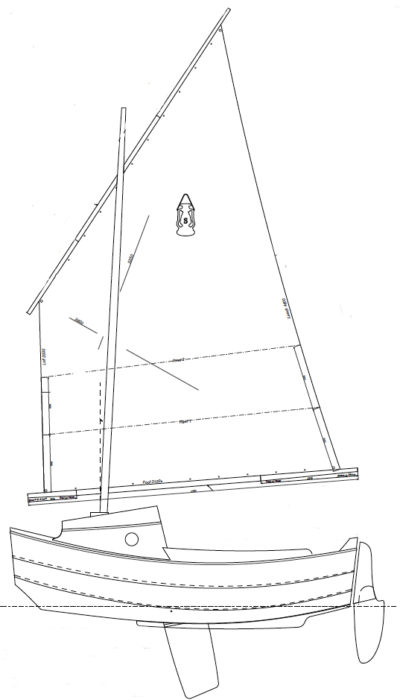
Plans and information are available from Small Craft Advisor . Their YouTube channel has several videos featuring the SCAMP, including a capsize trial with Howard Rice, below.
Is there a boat you’d like to know more about? Have you built one that you think other Small Boats Monthly readers would enjoy? Please email us!
Share this article
Join The Conversation
We welcome your comments about this article. If you’d like to include a photo or a video with your comment, please email the file or link.
Comments (4)
Great article! Thanks. I especially enjoyed the fact that during the capsize test, Howard did not lose his hat! Now that’s a sailor. I’ve always been off put by the punt bow, but seeing the boat in action, I can now appreciate it.
That boat did not want to capsize…
Thanks for the kind words about the article; I enjoyed yet another excuse to go sailing aboard a Scamp. It’s a fun and very very capable little boat, that’s for sure.
These are great wee boats, totally sold on the concept especially the seaworthiness. The only thing I would do differently is wear a safety harness in winds like that in the video! I could quite easily see the boat sailing off while you flounder around in the briny!
Comments are closed.
Stay On Course
More From This Issue
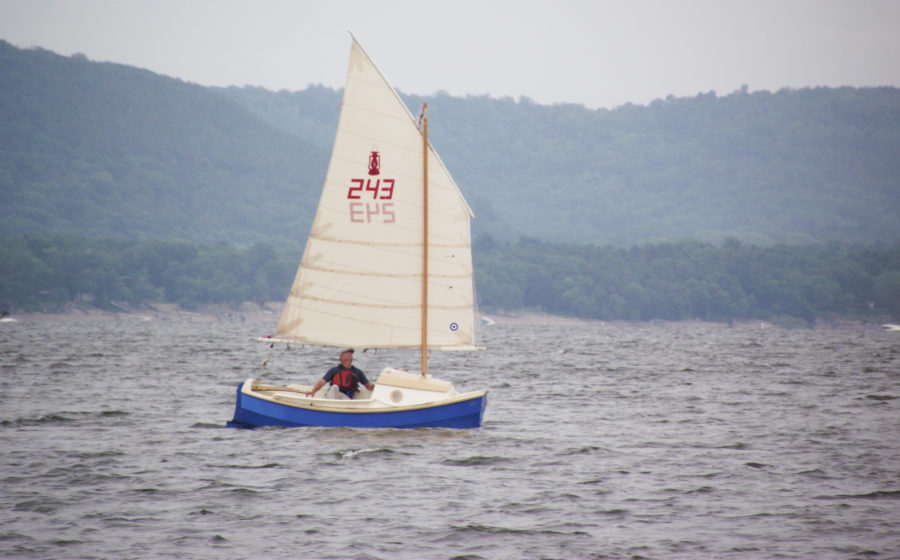
Never mind that until grounding on a mudflat less than 30 miles from the finish line, SCAMP #4 breezed through a difficult year in the 300-mile Everglades Challenge adventure race…
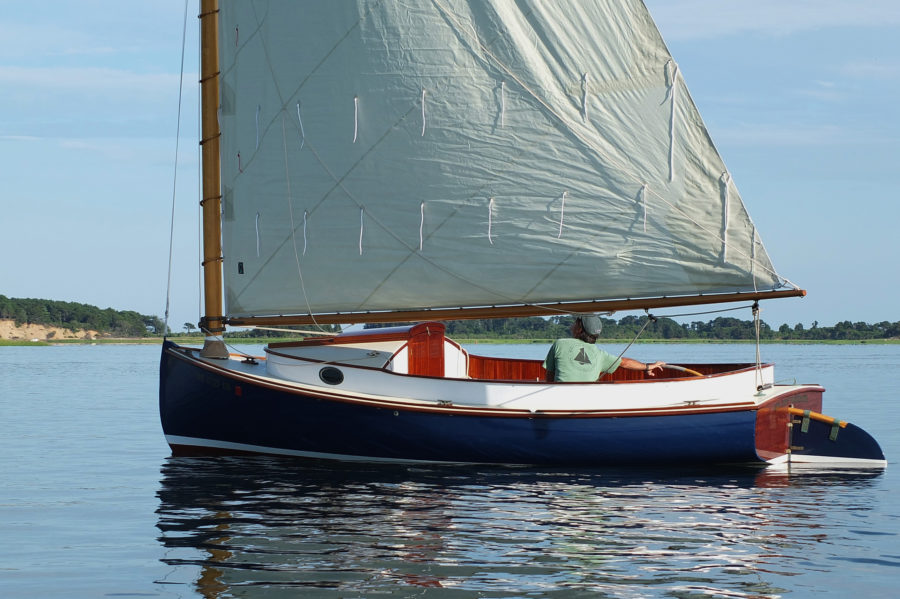
The Caracal
Arey’s Pond is a green, bowl-shaped jewel, one of several ponds in Orleans, Massachusetts, that give access, through narrow, winding waterways, to Little Pleasant Bay and, just to the south,…
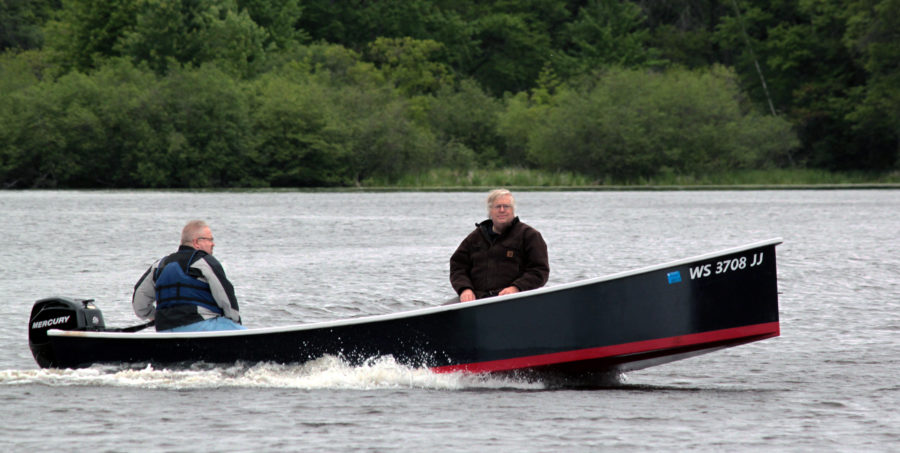
I’ve had a copy of Phil Bolger’s book Boats With An Open Mind for a long time, and I’ve always liked the looks of the Clam Skiff he designed for…
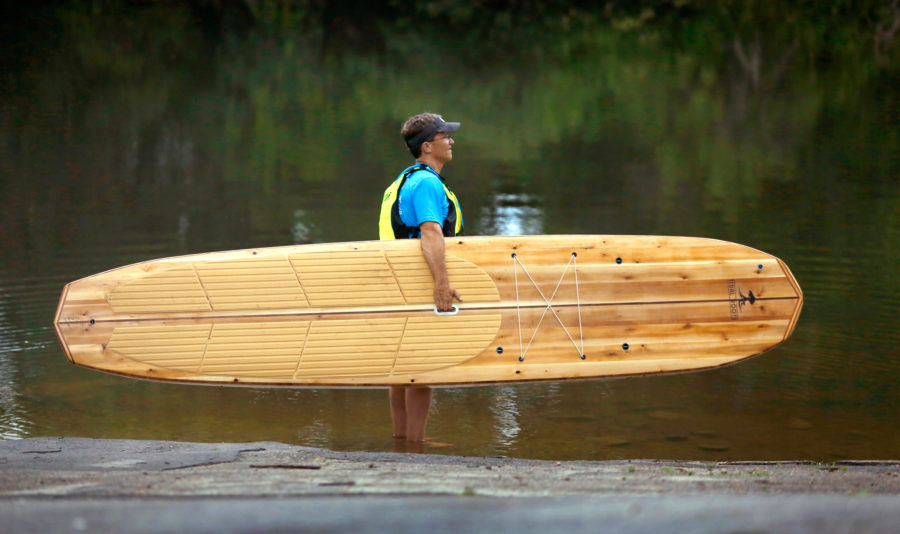
The Sand Bar by Tidal Roots
I was paddling on a placid Royal River with my four-year-old son Noah kneeling in front of me on a wooden Tidal Roots stand-up-paddle (SUP) board. The water hissed quietly…
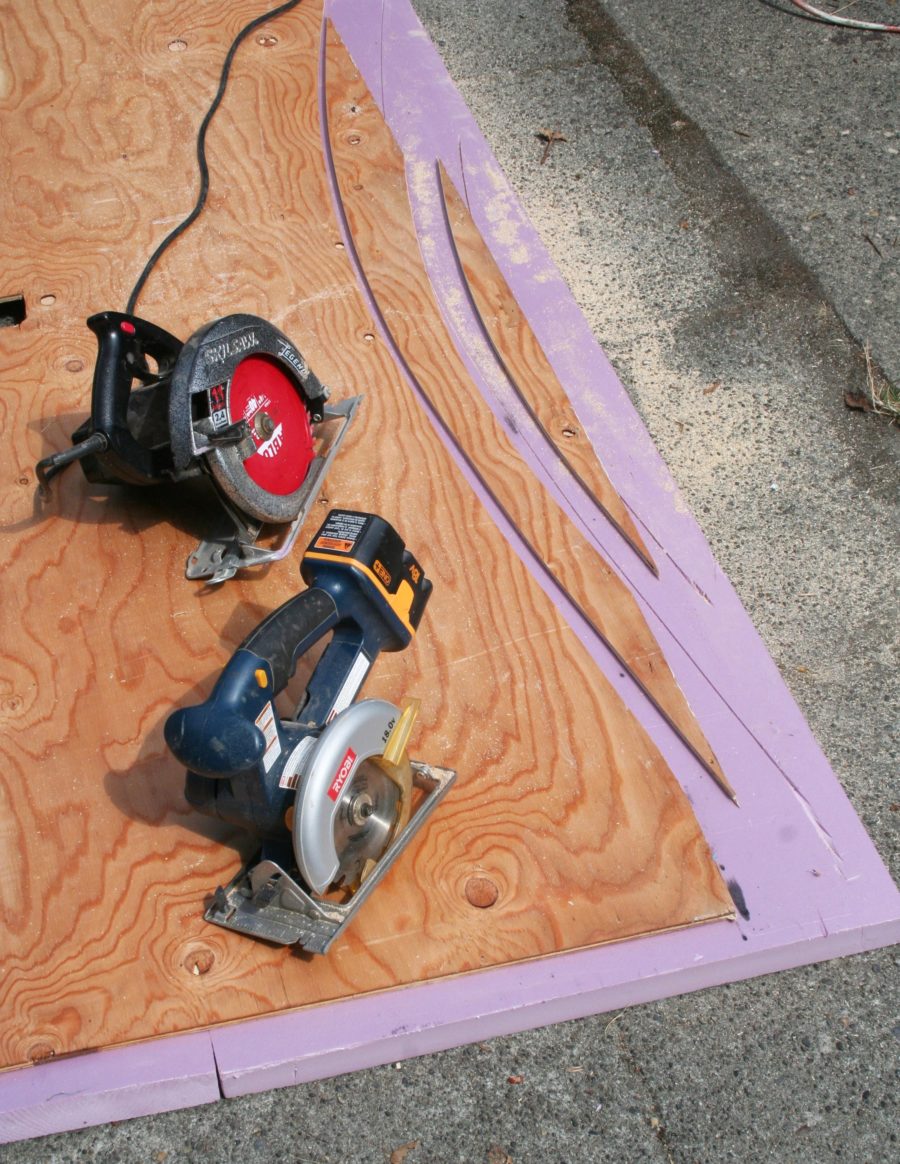
The Taming of the Sheet
Most of us who build boats at home do not have the facilities needed to handle 4′ x 8′ sheets of marine plywood with ease. I’ve always found it challenging…
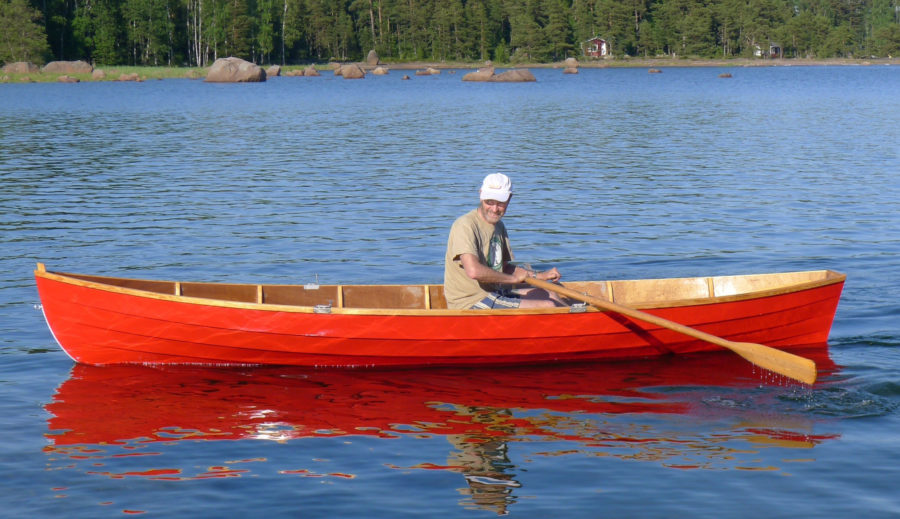
In Finland and much of the eastern Baltic region, networks of interlocking lakes were once the only links between settlements and farms; boats were the only form of transportation. The…
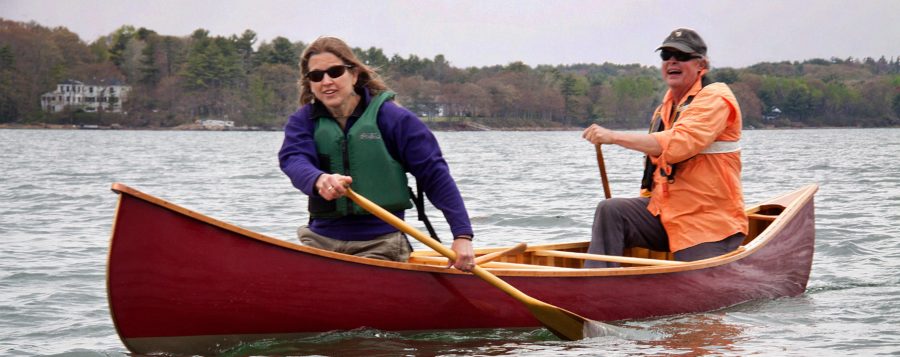
The E.M. White Guide Canoe
Not long after our first wedding anniversary—celebrated with an overnight canoe trip on the Narraguagus River in Maine—Sharon and I acquired our first boat, an 18′ Grumman aluminum canoe, complete…

Made in Vermont
I have always loved wooden boats of all kinds, but especially dories, for their elegant simplicity of design, the way they look upon the water, the way they handle in…
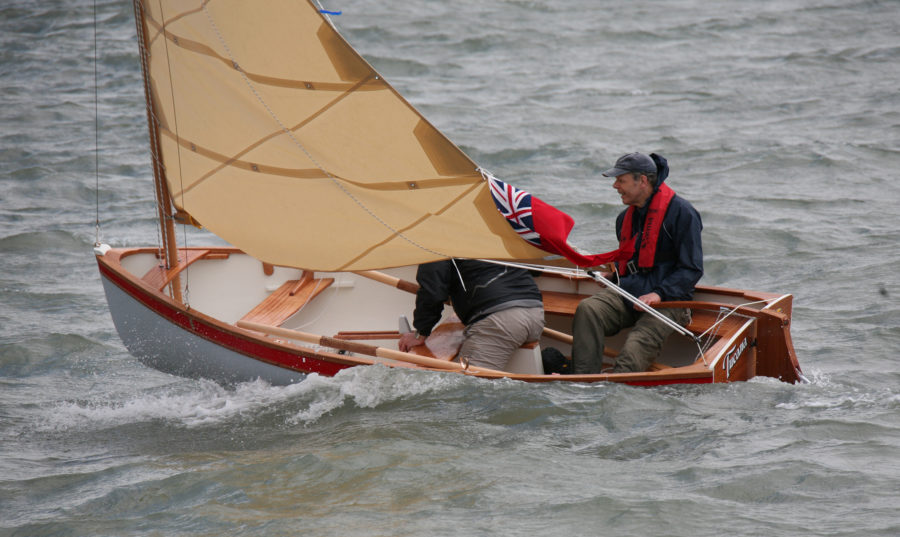
The Mallard
When the now-defunct magazine The Boatman was launched in the early 1990s, one of its objectives was to provide boat plans suitable for amateur construction. One such boat was the…
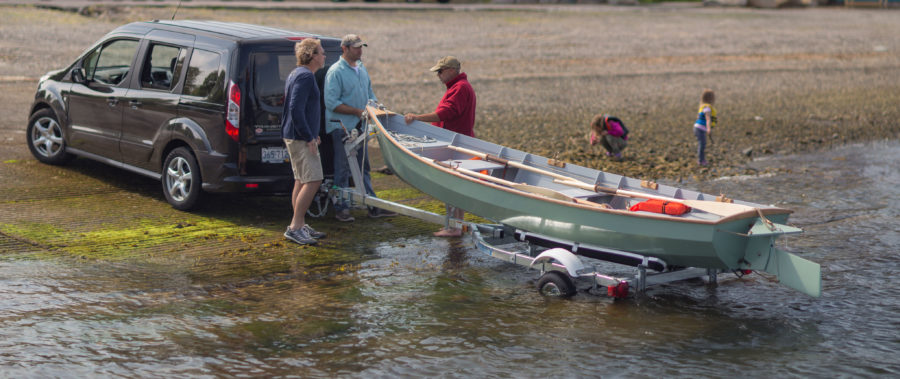
ZO Boats is a new company started by Bill Koffler and Scott O’Connell, partners in Aquidneck Custom Boatbuilding, a company specializing in high-tech composite construction. Involved in modern yacht construction…
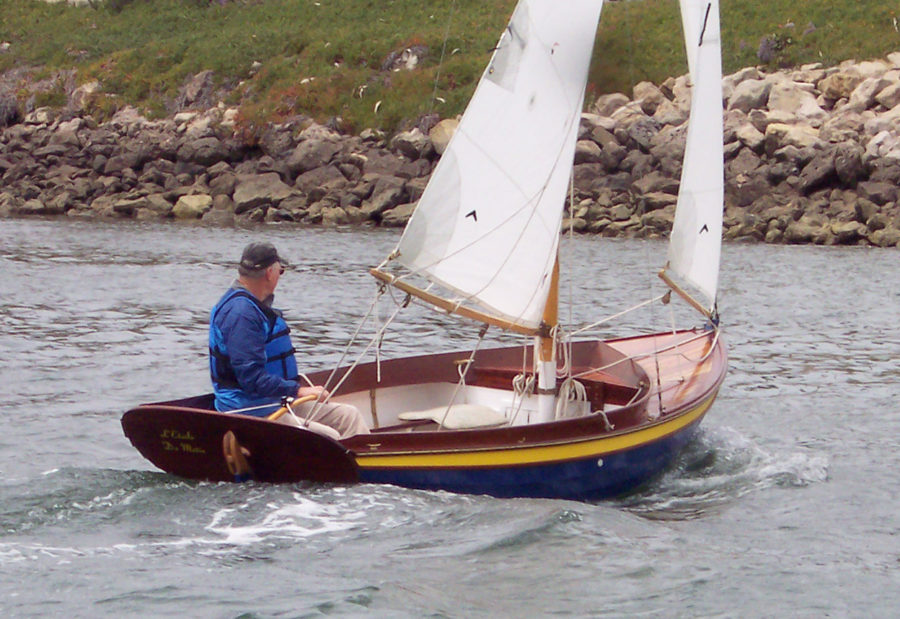
The Somes Sound 12½
A century ago Nathanael Herreshoff designed a 16′ keelboat known widely as the H 12½ after its 12′6″ waterline length. She was intended to handle the steep chop and strong…
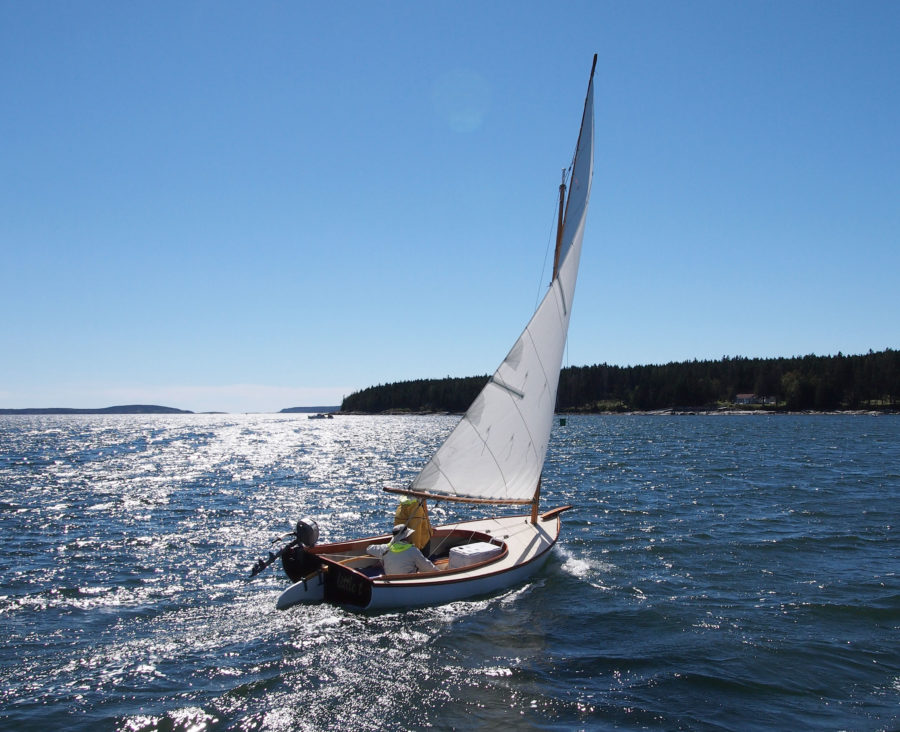
The Marsh Cat
I had spent a long time looking for a boat that I could build to sail the waters of Chesapeake Bay and beyond. The boat would need to be able…
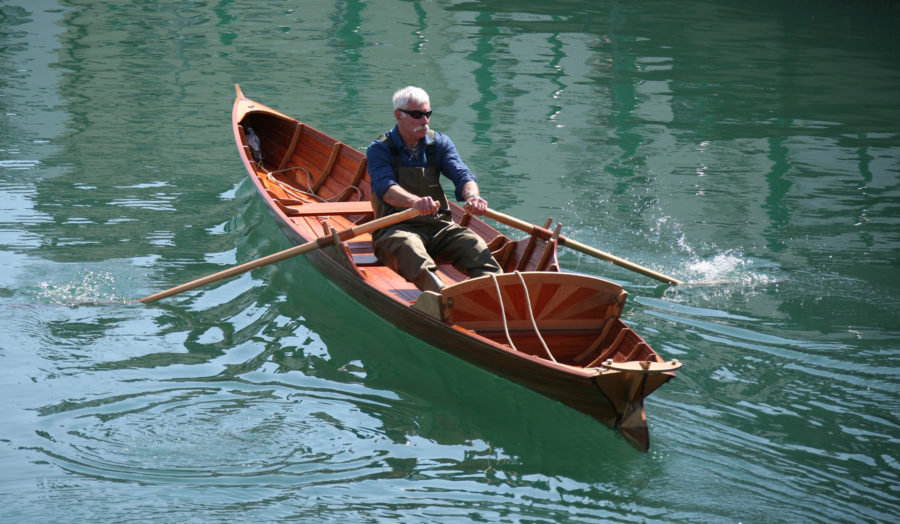
Within the pages of Eric McKee’s Working Boats of Great Britain there are drawings of a 24′ Thames skiff attributed to W.A.B. Hobbs* at Henley-on-Thames in the very early part…
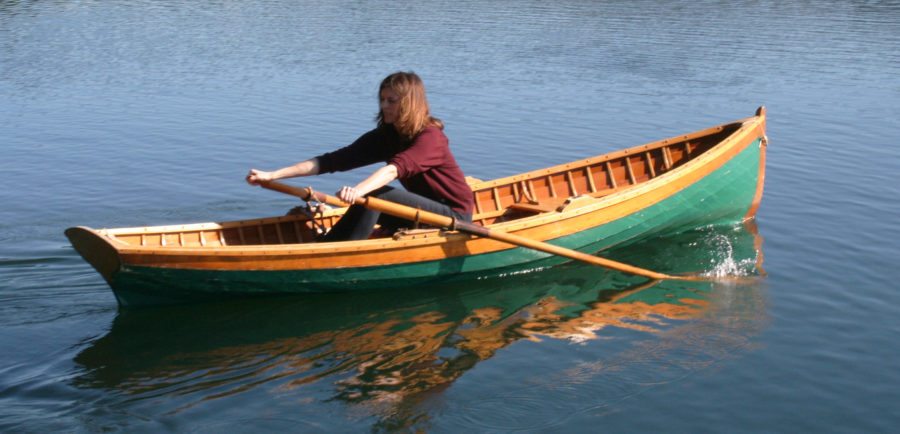
A Lapstrake Livery Boat
What was left of the boat rotting in the brambles on the north shore of Clear Lake in Western Washington was once a very fast boat under oars. Back in…
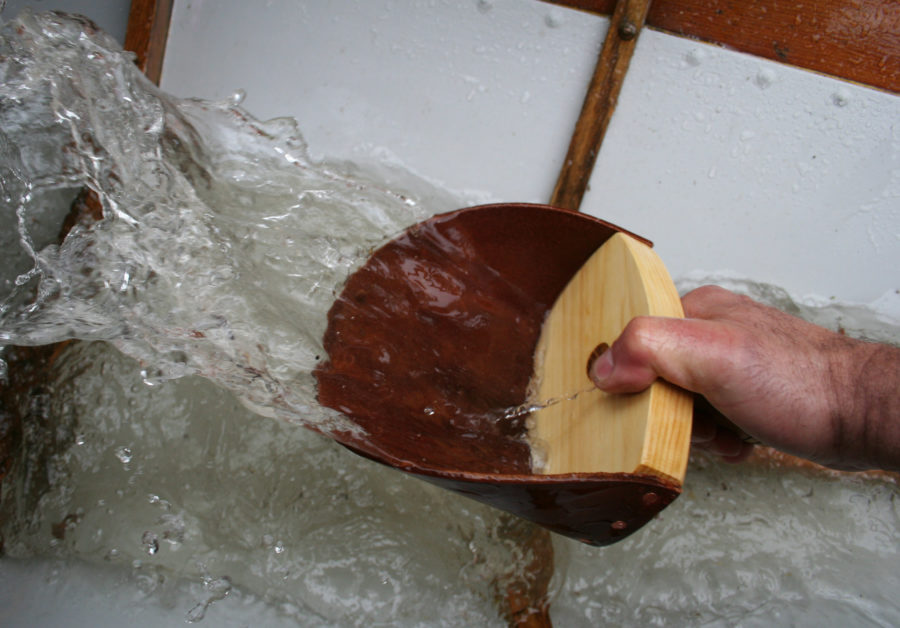
Making a Wood and Leather Scoop Bailer
Once upon a time the boat sharps on the Delaware River were sailing 15 footers with sail areas running to 400 sq ft. No self-bailers, no buoyancy tanks, no crash…
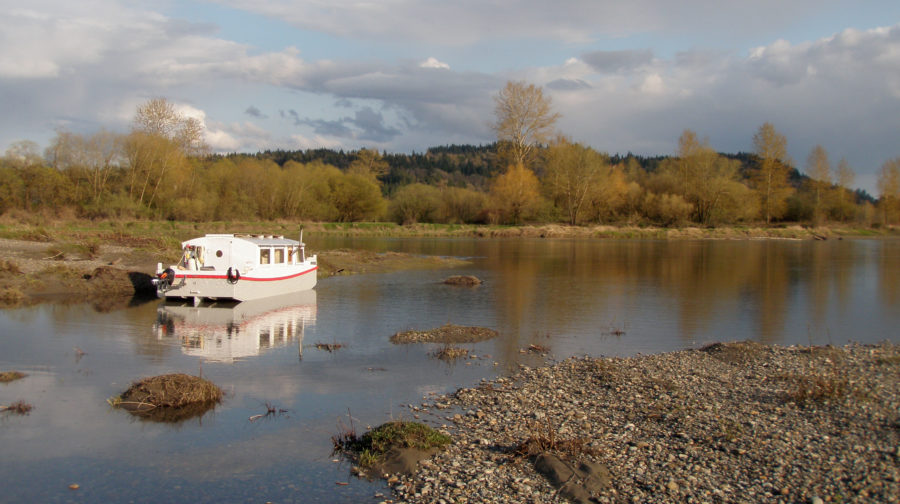
The Escargot canal cruiser
I was sitting in the cabin of the Escargot canal cruiser BONZO, a boat my son, Nate, and his friend Bobby Calnan built the summer after they’d graduated from high…
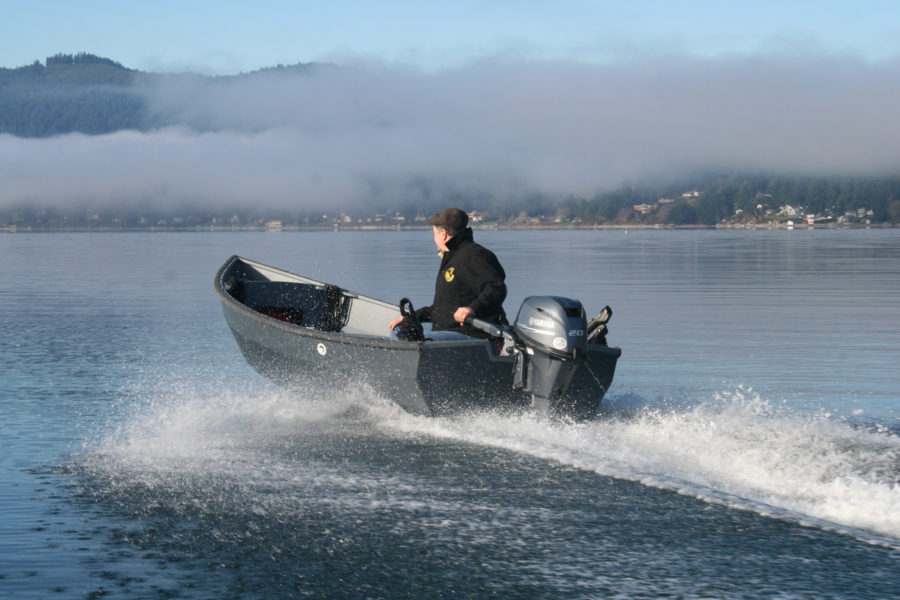
The Candlefish 13
Sam Devlin’s Candlefish 13 began with a client’s detailed request for the design of an outboard skiff suitable for the lakes of Alaska’s Far North. It had to be light…
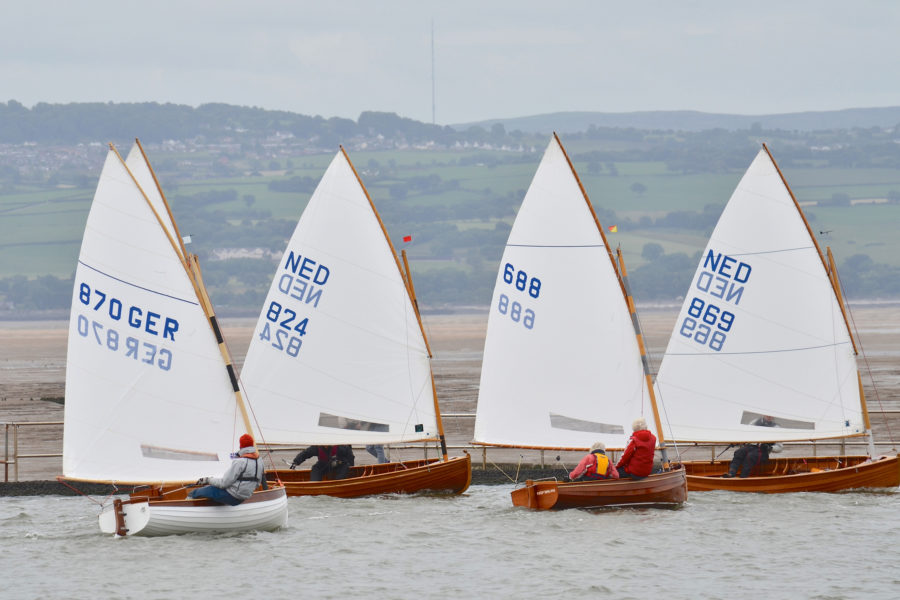
The International 12-Foot Dinghy
In 1913, shortly before the start of WWI, England’s Boat Racing Association (BRA), a small club of sailing enthusiasts, called for a design to comply with the following requirements: length…
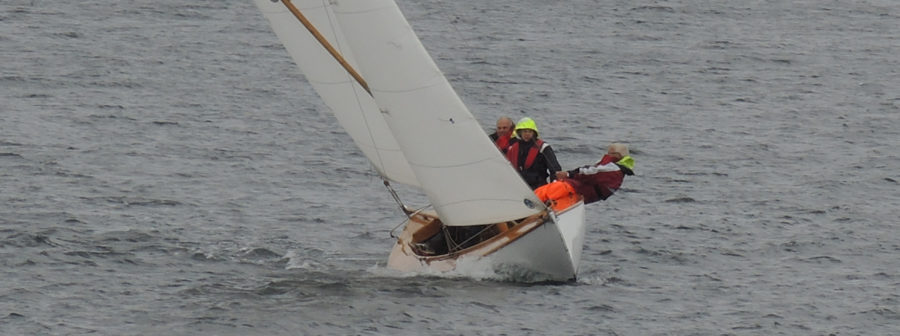
The Færder Snekke
Norway’s Færder snekker constitute a small racing class that hails from outside of Tjøme in the country’s Vestfold region, 55 nautical miles south of Oslo. The two-part name reflects the…
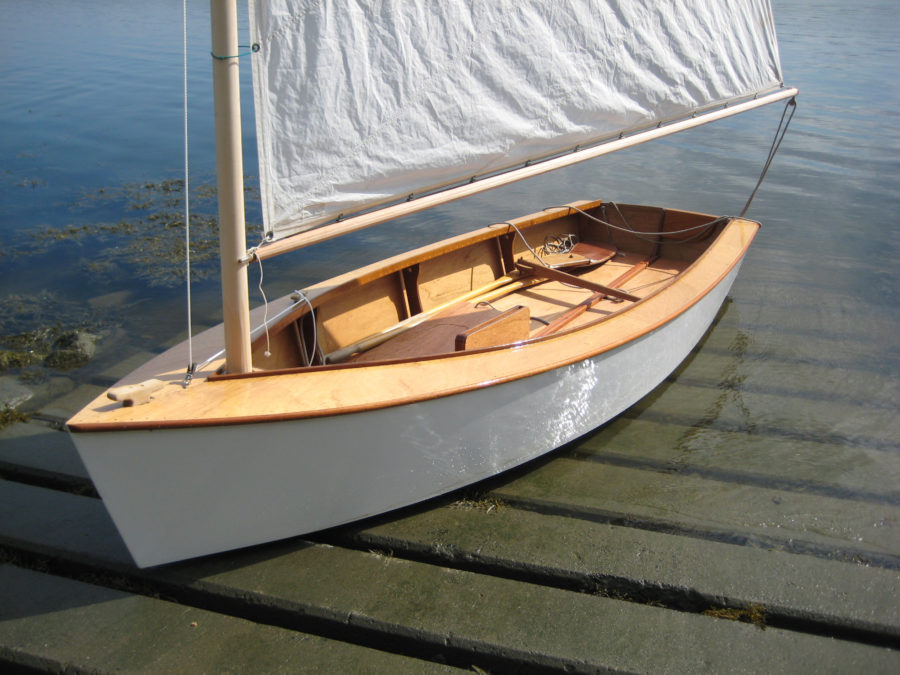
The MerryMac
The MerryMac catboat tends to make the blood hum with a sense of adventure and challenge. Its owners claim that it has always been so since the first of about…
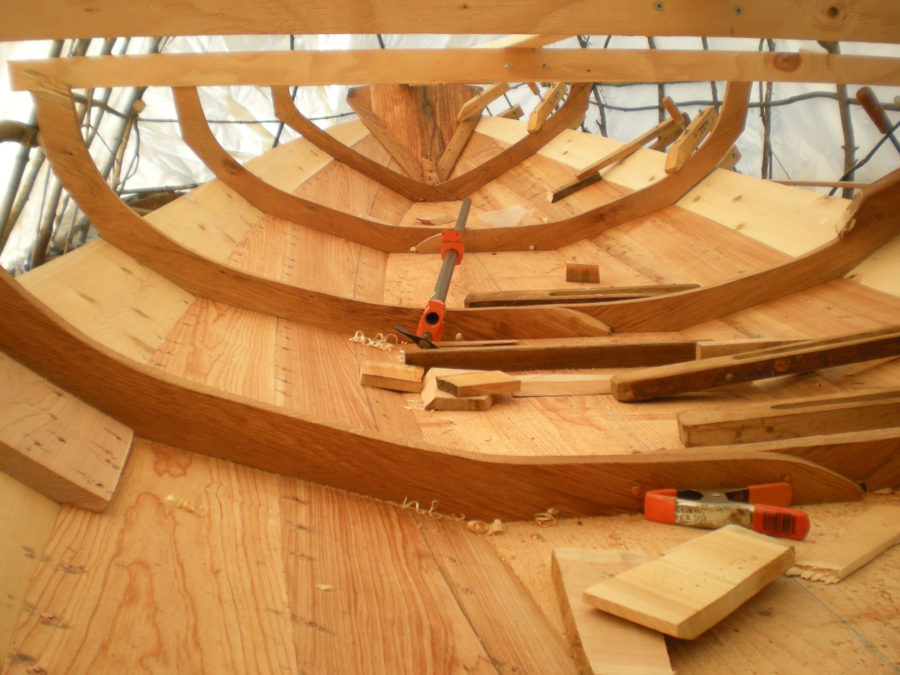
The Mower Dory
One day in the early 1990s, a local contractor visited my boatbuilding shop in Marblehead, Massachusetts, telling me he’d been hired to convert an old boatshop into a playhouse. “The…
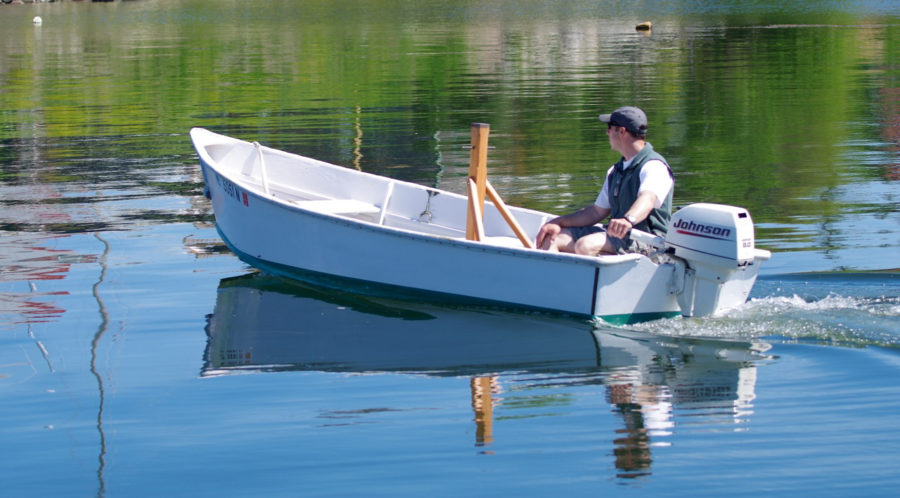
The Willis Boats of Maine’s Dark Harbor
At Dark Harbor, Maine, the legacy of the Rossiter Skiff outshines that of even its most popular fiberglass counterparts. Dark Harbor, located on the mid-coast island of Islesboro, is home…
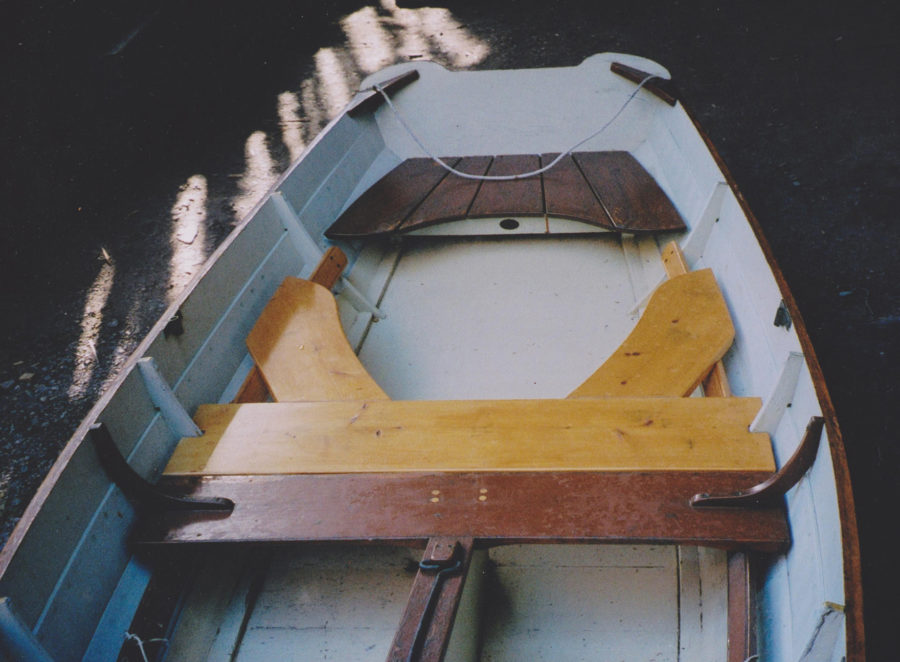
Comfortable Seating for Sailing a Small Rowing-and-Sailing Skiff
As age makes its inevitable changes to the sailor’s once supple joints, certain positions that were once assumed without thought become uncomfortable, if not actually painful. When I was younger…
More Boat Profile
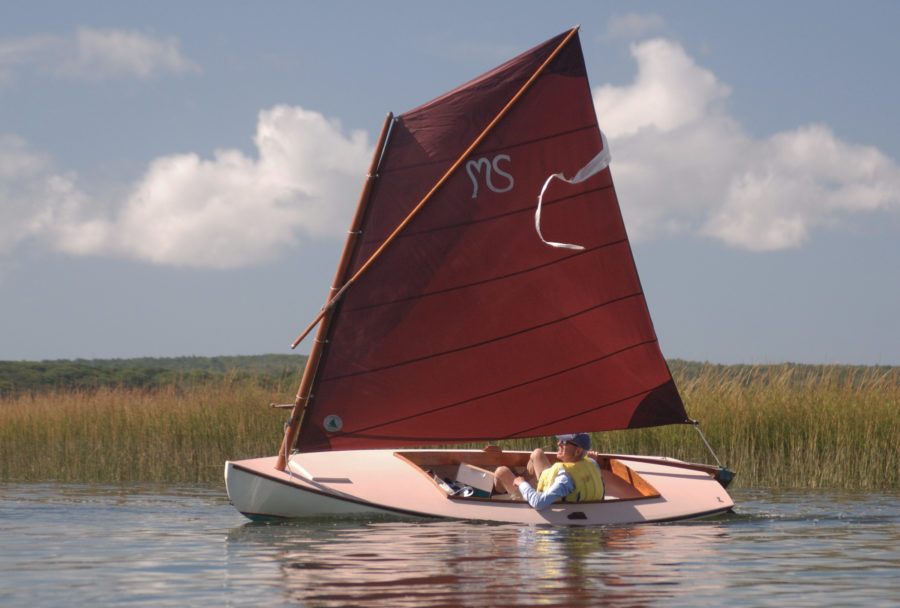
The Crawford Melonseed Skiff
The cockpit is a little over 6′ long—big enough for two people and a picnic. There’s room up under the deck for a cooler, anchor, and other gear, and a…
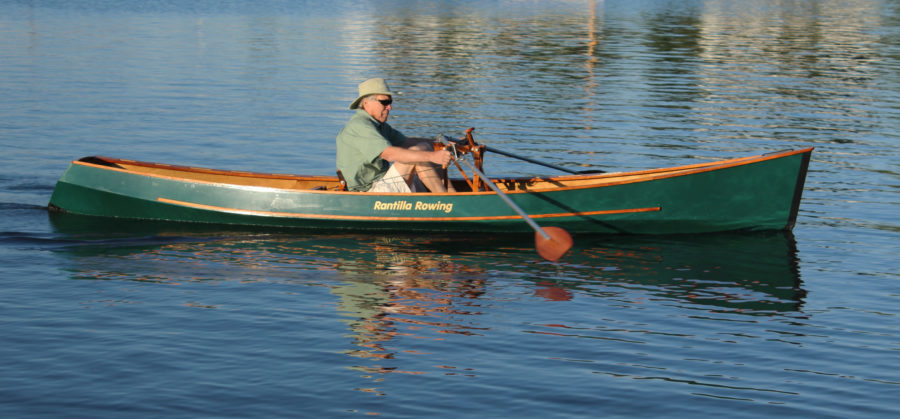
Odyssey 165
Ron Rantilla’s Odyssey 165 is an unusual rowboat for touring and exercise. It is specifically for use with his FrontRower, a drop-in forward-facing rowing system. With the oars fully supported…
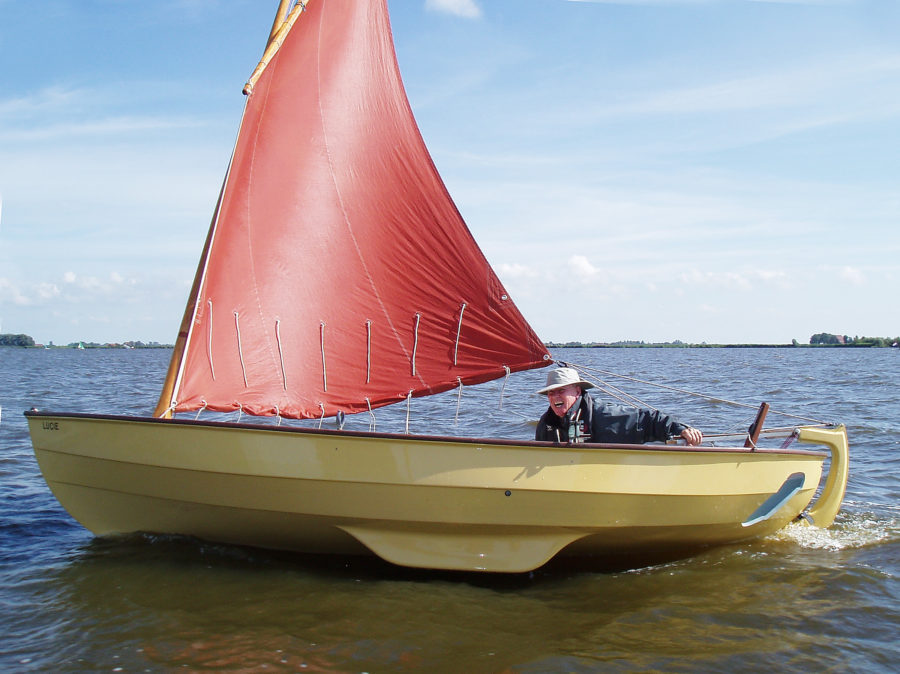
Devon Scaffie
The Scaffie was designed by John Watkinson, founder of the Drascombe line of small boats, and has been in production in the U.K. since 1978. It is 14′9″ long with…
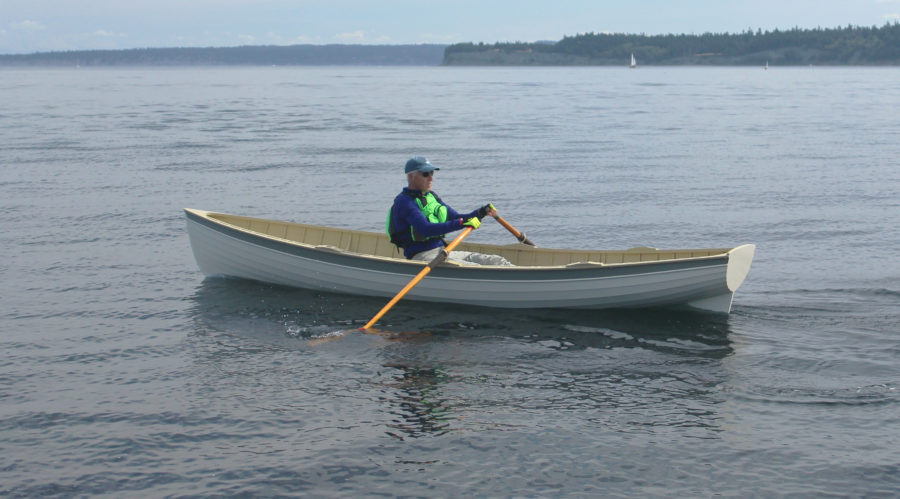
The Ebb is easily moved under oars, though its light weight made measuring its speed difficult. Weighing well under half my weight, the Ebb followed Newton's Third Law of Motion…
Subscribe Today!
Become a subscriber today and you’ll recieve a new issue every month plus unlimited access to our full archive of backlogged issues.
Already a subscriber? Sign In
Subscribe For Full Access
Flipbooks are available to paid subscribers only. Subscribe now or log in for access.

Small Craft Advisor
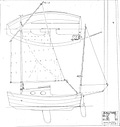
Boat Designs: Evaluating SCAMP’S Big Sister
(this new welsford cruiser checks a lot of boxes…).
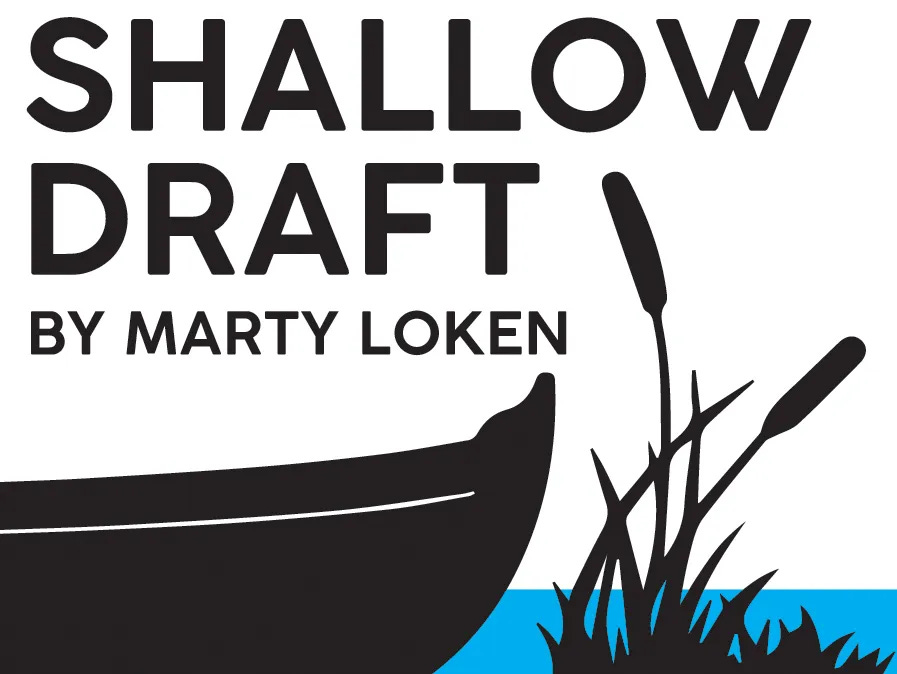
Over the past few days I’ve had email exchanges with John Welsford, New Zealand designer, regarding a brainstorm that’s been percolating in his clever, whimsical noggin: A bigger, more commodious takeoff on his wildly popular SCAMP design.
As most SCA readers know, the 11’ 11” SCAMP design was conceived 13 years ago when Josh Colvin, editor of this fine publication, asked Welsford to come up with a new kind of small cruising boat—one small enough to explore the most hard-to-penetrate backwaters, while being easy to rig, light enough to trailer with the smallest of tow vehicles, surprisingly great under sail, and comfy for overnight camp-cruising adventures. So, following some tweaks by designer and master boatbuilder Kees Prins, the resulting sailboat was dubbed SCAMP, for Small Craft Advisor Magazine Project.
SCAMP DRAWING…
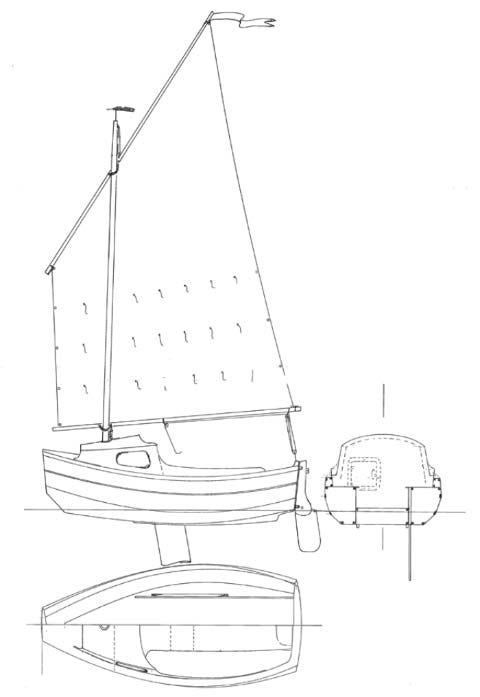
The rest is history: More building plans and kits for SCAMP have been sold over the years than any other small cruising boat we can think of. Besides the original wooden version, Gig Harbor Boat Works was licensed in 2013 to produce a fiberglass SCAMP, and the little giant killer—in wood and fiberglass—has since its debut been at the center of various small-boat rallies, workshops and sailing events.
While SCAMPs are still being built worldwide by enthusiasts, plan and kit sales have slowly been approaching what might be a kind of saturation point. It’s not that “everyone who wants a SCAMP has already built one,” but we get the feeling that it’s time for something new and different—like a SCAMP-inspired design that has the personality and quirky appeal of the original boat, but with more creature comforts (for an aging population of SCAMP lovers).
Meet SCALLYWAG, John Welsford’s big sister to SCAMP, a 15’ 4” x 7’ 3” wonder with a “real” cabin, tabernacle mast, mizzen sail, powerful main, water-ballast tanks, sitting headroom down below…and like SCAMP, faster than many onlookers might expect.
SCALLYWAG DRAWING…

This might turn out to be a timely, common-sense follow-up to the successful SCAMP design—so tempting that John Welsford is talking about building one for himself.
(As a footnote, we might add that in 2008, prior to the introduction of SCAMP in 2010, Welsford came up with another design that was similar to but somewhat larger than SCAMP—called TREAD LIGHTLY, which measured 13’ overall, with a beam of 5’ and addition of a mizzen. The series of similar hulls began with PEANUTS, an experimental build that never quite made the plans list. That design led to TENDER BEHIND, then SHERPA, then TREAD LIGHTLY, then SCAMP, then SCRAPS and now SCALLYWAG. Quite a series!)
TREAD LIGHTLY drawing…immediate predecessor to SCAMP)
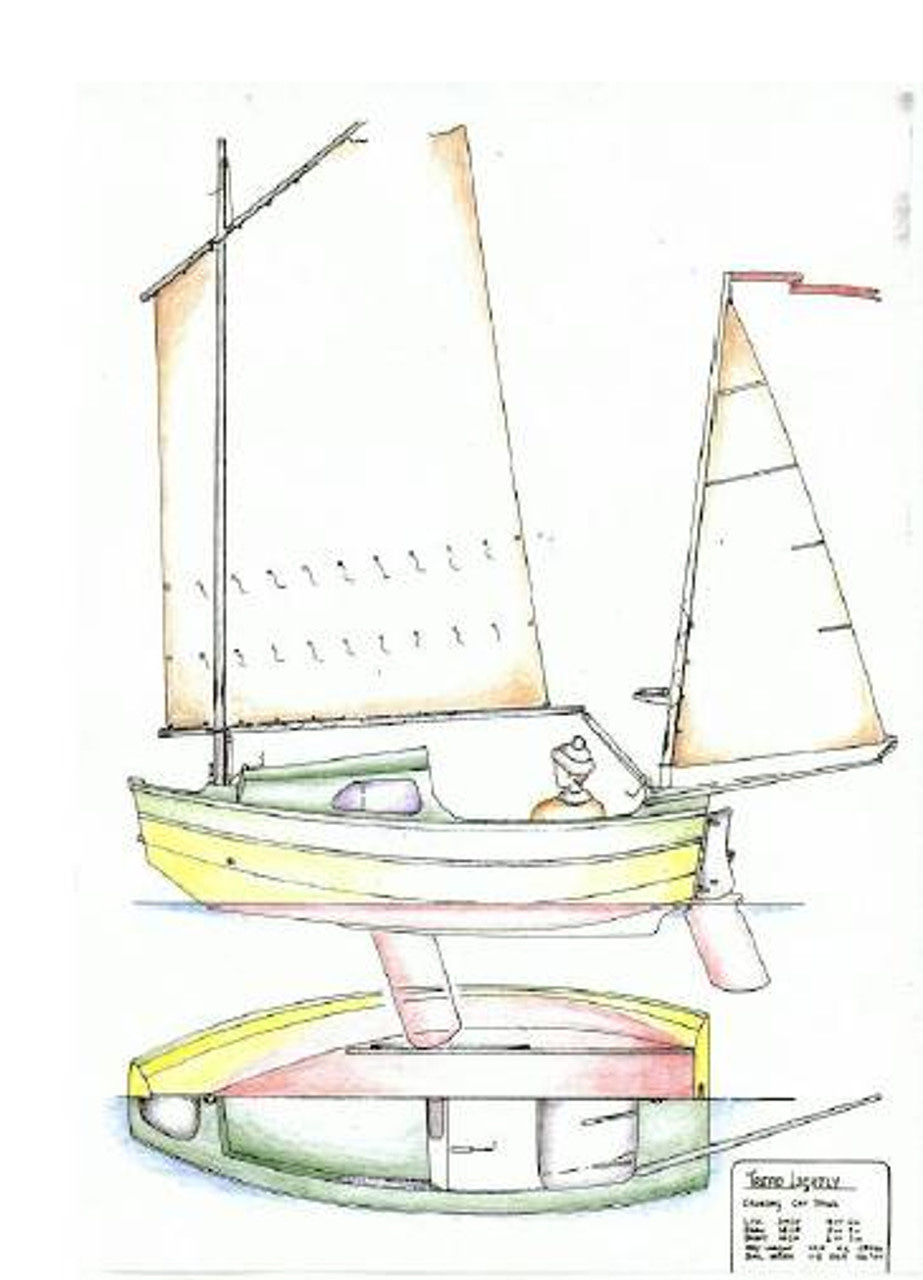
Here is John Welsford’s description of the SCALLYWAG design:
“I’ve had a number of people tell me they love SCAMP, but they’d like a ‘real’ cabin—something that would provide shelter for a couple of friends to overnight out of the rain; somewhere with space enough for four to sit and chat over coffee or rum on a cold evening; somewhere with a bench for a cooker, a table to eat the food off of, and lockers for all the essentials…and room for the skipper and first mate to stretch out and sleep in comfort.
“SCALLYWAG is not so big as to make launching and retrieving a chore; her mainmast is in a tabernacle, which makes standing it up easy-peasy for clients who don’t like the idea of lifting a mast that size vertically into place. Her mizzen is light enough to not be a worry, too, in that respect.
“The rig is a powerful one, but easy to access for reefing, and she will heave to under mizzen with the main let free so she sits mostly head-to-wind, dry and restful if a gust has to be waited out.
“I’ve added a pair of big water tanks for ballast, so with that and her beamy shape she’ll be very stable. Her cockpit self-drains, the motor is inside the tall transom for easy access, and while there’s room in the cockpit for four, she’ll be easy to single-hand and relaxing to sail.
“While the relationship between SCALLYWAG and SCAMP is obvious, it’s not just the styling. The backroom calculations in hydrodynamics suggest she’ll handle well, and be faster than many expect. With high stability and the ability to sit upright when aground, she’ll be able to transition from hiding in the mud or sand up a creek somewhere, to making a longer coastal passage without any fuss.
“Construction is simply plywood over ply bulkheads, with stringers to line everything up, and with considerable buoyancy just in case. The plans will have scale drawings of all major components, and we anticipate soon having printable full-sized templates for frames and other key items.”
As for specifications, beyond the overall length of 15’ 4” and beam of 7’ 3,” SCALLYWAG will have board-up draft of 10,” a board-down draft of 3’ 4,” a total sail area of 143 s.f. and a fully-rigged dry weight of 750 lbs. (Incidentally, the beam-to-length ratios of SCAMP and SCALLYWAG are almost identical.)
John Welsford says that plans for SCALLYWAG will be available on December 1, but he can take orders in the meantime. Price will be $245 U.S. funds for emailed, printable PDFs, and the plans can be ordered via John’s website: jwboatdesigns.co.nz (Joel Bergen, well-known for the Welsford Navigator he built and sails in many Northwest small-boat events, will be developing a set of SCALLYWAG patterns in the not-distant future, according to Welsford. Editor’s note: We heard from Joel yesterday; he’s hoping to develop CAD-produced patterns “in a few weeks,” now that he’s received initial SCALLYWAG drawings. Stay tuned; we’ll provide updates on plans and patterns in this space.)
FIRST IMPRESSIONS OF THE SCALLYWAG DESIGN:
Eager to hear what SCAMP-savvy friends might have to say about the SCALLYWAG specs and just-released drawing, we sought initial reactions from…
JOSH COLVIN, editor of Small Craft Advisor , who commissioned the SCAMP design in 2010 and enjoys sailing SCAMP #1:
“There’s certainly no doubt who designed this one! It looks almost as much like Welsford’s PENGUIN as a SCAMP. SCALLYWAG’s length is a sweet spot in terms of accommodations potential. She’ll be rowed less than most SCAMPs, but I love the inboard motor well to keep her lines clean, and the engine right at hand. But her most exciting feature is the addition of the mizzen, which will improve seaworthiness and make managing the mainsail easier.
“Between LONG STEPS and SCALLYWAG, those looking for something like SCAMP, but larger, have great options. I’m excited to see the first boat built—she will be bigger than most expect, just looking at the drawing.” SIMEON BALDWIN, builder of an early SCAMP who has perhaps sailed more nautical miles with a SCAMP than anyone…and who has also served as a generous advisor to fellow SCAMP builders and is an expert on rigging and sailing the little 11’ 11” boats:
“I like what I see of this long-rumored design. Knowing John and his attention to ergonomics, I can anticipate it will work well. The tabernacled mast and addition of a mizzen are most appealing.
“From the drawing I think it may resemble LONG STEPS in terms of the recessed footwell. It also appears he is eschewing a by-design lazarette made popular by many SCAMP owners.
“The double water tanks are something to contemplate. I don’t envision SCALLYWAG as a purpose-built racer with crew, actively keeping high-side ballast on long tacks, like the SKATE 15 that Brandon Davis designed, which utilizes two tanks and a dump-valve system that may be more elaborate than a typical cruising sailor would want to live with. But John may be describing two water tanks that are filled and remain separate from one another.”
(Editor’s note: Welsford’s comment on tanks, “The ballast tanks are linked, and they’re not far enough off the centerline to work independently. There is one each side of the aft end of the centerboard case and they go out as far as the seat-front extensions.”)
“I’m looking forward to how all of this works out!”
BRANDON DAVIS, of Turn Point Design in Port Townsend, whose company cuts CNC kits for the SCAMP and a variety of other small boats. Brandon is also a skilled designer and small-boat sailor:
“I really like this boat, since it has just enough room to have a cabin but it’s still small enough to be trailered, beached and easily built in a garage. The enclosed cabin should encourage longer trips or taking a friend along.
“The longer waterline should increase average sailing speeds. My guess is that rowing speed will be lower than the SCAMP, as the rower will not be able to take advantage of the waterline length because of her weight.
“Will SCALLYWAG be offered as a kit? I could see it selling well as a kit and the market could be ripe. Many SCAMP builders might consider this as their next build.
“I look forward to seeing the first SCALLYWAGs on the water!”
KEES PRINS, designer and boatbuilder, who constructed the first SCAMP while serving as boatshop manager at the Northwest Maritime Center…and in the process suggested and implemented some changes that improved the design:
“I think SCALLYWAG will find a great following in the SCAMP world and beyond. Adding a cabin will greatly enlarge the ‘SCAMP Crowd.’ At that beam, and with twin ballast tanks, stability should be enormous for a boat this length. I would have liked to see a cross section through the cabin to know more about sitting comfort. (Four people hanging out inside seems a little optimistic, but two should be comfortable.)
“I’m curious about what the tabernacle for the unsupported mast will look like. A big sail area, together with a stiff hull will induce a significant load on the tabernacle. There seems to be a deep well for the mast base to swing through, judging by the drain hole.
“All in all, SCALLYWAG looks very promising.”
OSCAR LIND, a serious student of all various small-boat designs , and earlier builder of a SCAMP, who shares at least one thing in common with John Welsford—they’ve never met a pun they didn’t like:
“I might have to clear out the shop and make as much room as possible to build this boat (due to the 7’ 3” beam, especially). It’s so tempting and fills the bill for usability and function.
“It does need a Chinese lug rig, though. I expect quite a few SCALLYWAGS will ultimately be built.”
(Editor’s note: John Welsford comments, “I like the Chinese lugsail, but for a sail of this size on a boat that will be trailered, rigged and derigged for each outing and dry-stored, the extra complexity of the Junk sail slows the process. As well, the balanced lug is in my experience, a little quicker upwind—unless the junk rig has cambered-panel sails, and there are few sailmakers producing those, so I think in this case, simplicity and performance get the nod.”)
As for my personal view as a serial boatbuilder, restorer and sometimes buyer of project boats, I enjoyed owning a SCAMP several years ago. While I loved sailing the boat, I wished it was bigger and included a sleeping cabin. So, John’s new SCALLYWAG design checks many more boxes as an all-around keeper, and I prefer its overall hull, cabin and rig design, not to mention its potential as a serious cruising machine.
So, once again, here’s a chance for you, as a fellow boat nut, to offer your evaluation of SCAMP and her newly-hatched big sister, SCALLYWAG. (Also, please add other thoughts in the comments section below…) • SCA •
Ready for more?

Call Us: (253) 851-2126 Mon-Fri 9-5 Pacific Time
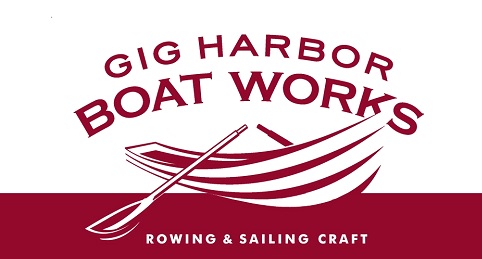

Fiberglass SCAMP review in 48 North
by GHBoats Webmaster | Apr 12, 2014 | Press Reviews , SCAMP

Our fiberglass SCAMP got a fantastic write-up in the April 2014 issue of 48 North !

It’s a pretty good sized article so we’re not going to reprint the whole thing here, but these are a few of our favorite parts:
Gig Harbor Boat Works, known for their strong, esthetically pleasing rowing boats, has already shipped a number of the new SCAMPS all over the country and overseas. “The kit boat has a lot of intricate details that the home builder may not have the talent or tools to build,” says Dave Robertson, owner of GHB. “With the fiberglass version, they can enjoy using the boat right away.” The GHB boat is truly sail-away complete; from oars to sails.
There are many innovations designed into the SCAMP that make it truly a big little boat. One thing that usually takes up a lot of cockpit room of most small boats is the centerboard. The SCAMP’s centerboard, very heavy but swings up easily for trailer or grounding, is offset to starboard so that it doesn’t intrude into the cockpit. I’ll let you call Dave to explain the physics of the offset. Suffice it to say that we didn’t notice a difference on either tack. The result is it opens up the cockpit which feels more like that of a of a San Juan 24.
The boat was surprisingly quick and very stable. “This boat can’t be just 12’long,” I thought. I stood up and rocked it side to side with minimal affect. It felt like 20-footer. Sailing the SCAMP made me a believer that it actually would be a safe and enjoyable way to explore the San Juans, as well as just knocking around the bay for a fun day of sailing. The SCAMP had lots of surprises, all good. I have to say it’s the biggest little boat I’ve ever sailed.
You can download a PDF of the full review here: 48 North Scamp Review
Newest Posts
- Lobster Boat Redesign — Update #2
- Mailbag: Family Diving from a 14′ Whitehall
- New Year, New Digs!
- Save the Date: Seattle Boat Show Feb 2-10, 2024
- Wild Places: Sleeping Aboard the Salish Voyager
- Beach Dolly (1)
- Best of GHBoats (5)
- Customer Questions (8)
- Customization (1)
- Galleries (4)
- Maintenance and Repairs (3)
- Announcements (13)
- Boat Shows (12)
- Just for Fun (17)
- Mailbag (43)
- Newsletters (25)
- Ocean Rowing (13)
- Press Reviews (10)
- Now Hiring (1)
- Woodwork (3)
- Captain's Gig (2)
- Jersey Skiff (4)
- Lobster Boat (4)
- Melonseed (6)
- Navigator (4)
- Nisqually (2)
- Point Defiance (7)
- Salish Voyager (17)
- Swampscott Dory (1)
- Whitehall (6)
- Sea Stories (12)
- Site Guide (4)
- Uncategorized (1)
Blog Archives
Site search.
SCA (Small Craft Advisor) Editors on SCAMP
"What does a man need-really need? A few pounds of food each day, heat and shelter, six feet to lie down in-and some form of working activity that will yield a sense of accomplishment. That's all-in the material sense, and we know it. But we are brainwashed by our economic system until we end up in a tomb beneath a pyramid of time payments, mortgages, preposterous gadgetry, playthings that divert our attention for the sheer idiocy of the charade. The years thunder by, the dreams of youth grow dim where they lie caked in dust on the shelves of patience. Before we know it, the tomb is sealed. Where, then, lies the answer? In choice. Which shall it be: bankruptcy of purse or bankruptcy of life?" -Sterling Hayden
Our own youthful dreams often featured small boats in supporting roles. Stalwart little vessels aboard which we'd venture across nebulous bodies of water in search of uncharted shores and uninhabited islands. Sometimes we'd land and go ashore to explore or make camp, often retreating to our boats to wait out a summer storm beneath a boom tent. We'd read sea stories by oil lantern and, on clear nights, sleep under a blanket of stars.
Curiously, these fanciful voyages never involved wrestling with a heavy mast, fussing with a smelly outboard, or being held off shore by our boat's draft. And even when we pictured whitecaps kicked up by a stout afternoon breeze, never was there a chilly capsize.
It was a longing for those simple pleasures that inspired thoughts of SCAMP. That and a persistent desire to go over "there"-that place we often see but can never quite reach. It seems to happen on every cruise. Never mind that we're usually sailing the smallest boat around for miles. We always come upon some ultra-shallow bay or intriguing tidal stream that disappears into the reeds, trees and rushes. To get in there-all the way in there-a boat needs to be light, shallow and easily propelled-and preferably flat-bottomed should we decide to stay though the ebb.
Trying our best to distill small-boat cruising to its essence, we sorted out our ideas and took the best of them to one of our favorite designers-John Welsford. It shouldn't have surprised us that, being of a like mind, he responded enthusiastically.
What we commissioned was the most micro of cruisers. We wanted a cabin, not for a claustrophobic casket-like berth-but for dry stowage, buoyancy and a bulwark against wind and seas. We tried to be honest about the compromises. In describing the boat to John we said SCAMP would be so small that, "the designer himself might cringe a little when he puts the pencil down."
Remarkably, where we expected John would need eleven or even twelve feet to meet our goals, he was able to do so in slightly over ten. And where we'd resigned ourselves to the possibility she might be at least slightly less capable than larger microcruisers, John drew SCAMP with a selfdraining cockpit, abundant flotation, and 145-pounds of water ballast. Unlike many larger designs, SCAMP should be recoverable from a complete capsize.
We've long been fans of pram bows and how they maximize volume at a given hull length, and before we could ask, John's initial reply suggested one for SCAMP
Thanks to an offset centerboard the cockpit sole/ single berth measures 25 x 77 inches, making accommodations almost luxurious for the solo sailor. Designed to be sailed, rowed and perhaps sculled, SCAMP can also be fitted with an outboard in place of her rudder-or with an optional mount for a trolling motor.
We believe every boat needs a bucket, so we asked John if he could design in a designated spot for one. He did. Every SCAMP sailor will have at hand a storage container, fire extinguisher, drogue or emergency steering aid, rudimentary head, bailing device, and a tool for filling the ballast tanks.
We wanted the simplicity of a single sail (single halyard, single sheet, etc.) and John wisely recommended the balanced lug. Although we're fans of this rig and unanimously saw it as the best choice, we wondered if some potential builders might prefer the more familiar gaff sail. At our urging, and with some reluctance, John drew SCAMP with a gaff. The resultant drawing with the much higher aspect rig looked less purposeful, unwieldy-almost fragile. Seeing SCAMP dressed like this so convinced us of the balanced lug's better suitability that we scrapped the gaff option altogether. John appreciated our coming to our senses and wrote, "The lugsail gets the right amount of area in the space available without getting outside the ends of the boat or going up too high. Remember that this is a very stable boat, and can carry a lot of sail without risk, and that's one of the strengths of the lugsail."
John suggests a practiced amateur could have the construction done and ready for paint in about 110 hours. It's our hope that new sailors and first-time builders will appreciate the small size and simplicity of the design, and that more experienced builders and sailors will appreciate SCAMP's surprising level of sophistication.
Although SCAMP wasn't designed specifically with kids in mind, we think she would make an ideal exploration boat for young sailors-safe, capable and easily handled. We intend to donate a set of plans to any formal organization or school looking to build a SCAMP for this purpose.
Now on to the next step-finding a builder for the prototype and getting SCAMP in the water! SCA
SCAMP Plans are available at Duckworks


- Boat Reviews
- Retro Boats
- Digital Edition
- Competitions
LITTLE BEAUTY
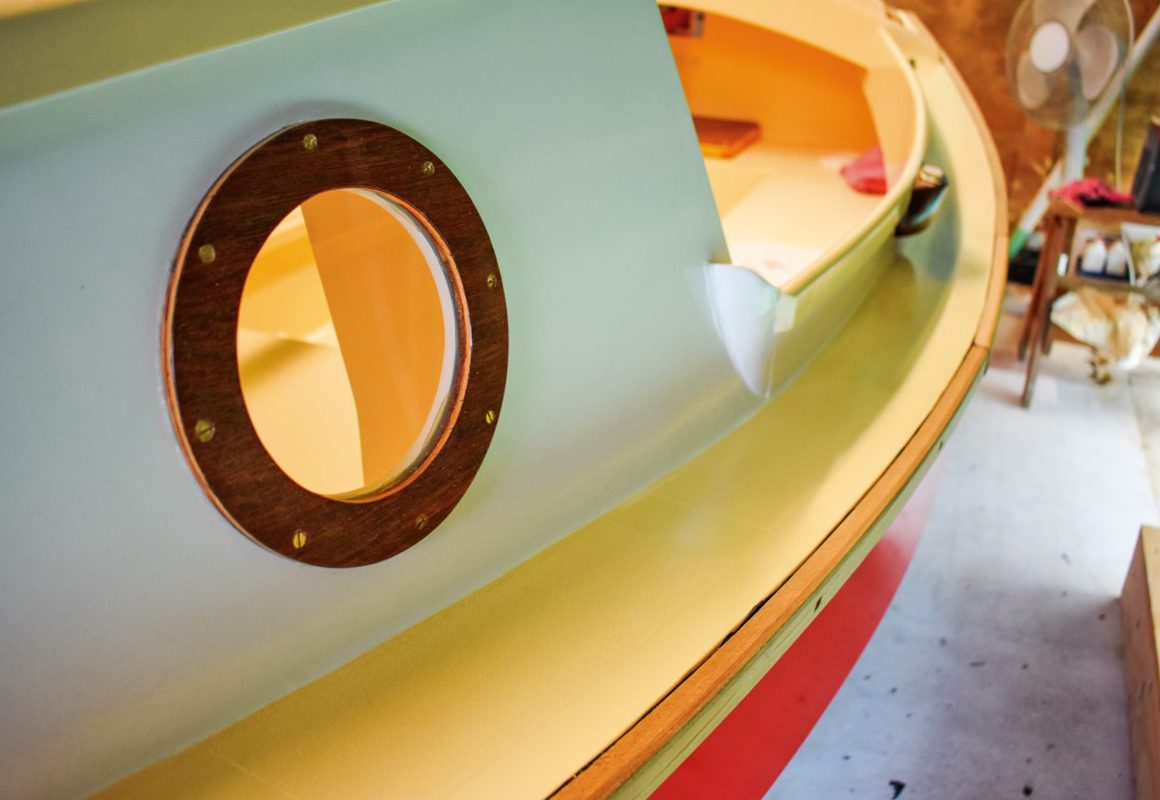
A brief look at the short end of ocean cruising, by Lindsay Wright.
There’s a certain appeal to a boat design called SCAMP. According to the Oxford dictionary, it means ‘rascal’ or ‘rogue’ and the verb form is even better. To scamper is to ‘run’ and ‘skip.’
Perfect for a 3.64m pram-bowed cruising yacht like the one being readied for launching from Steve Grimwood’s shed in Inglewood, Taranaki.
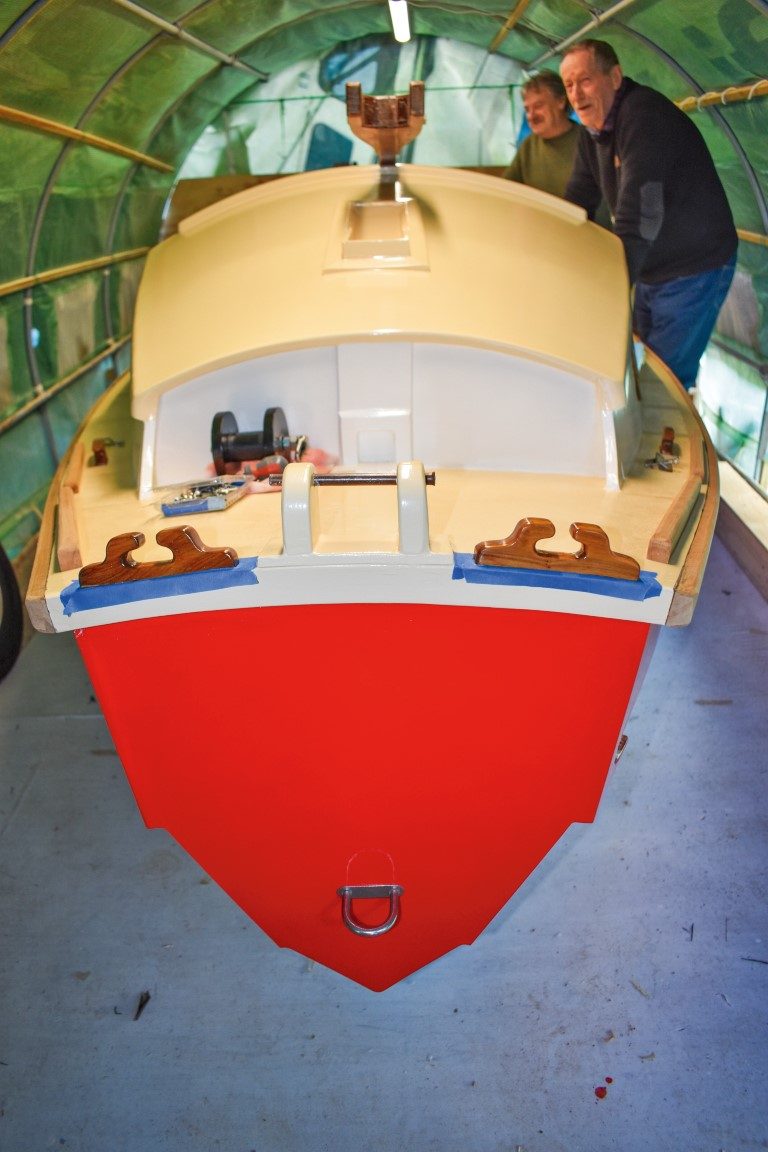
SCAMP is an acronym of the American Small Craft Advisor Magazine, a periodical published in Washington State, USA, with Project tacked on. Publishers Craig Wagner and Josh Colvin had sailed over 70 boats for the magazine and wanted a boat that was easy to build and shallow enough to go gunkholing in their Columbia River. But also capable of handling the challenging conditions produced by the river, wind and tidal conditions.
So they contacted Kiwi designer John Welsford, who drew a design to suit their requirements. “SCAMP is number 6 in a series of very beamy shallow-bodied designs with a distinctive high-positioned pram bow,” says John. “They all work really well, can carry huge loads for their size, are well-balanced and sail well. I’ve learned something from every one of them.”
The SCAMP plans were sent to the US in 2010 and by October that year the first SCAMP was up and sailing. By 2011 SCAMPS were sprouting all over the world. Over 340 sets of plans have been sold and about 60 boats launched.
Among those is Inglewood boatbuilder, Steve Grimwood, an English immigrant to New Zealand who had worked on superyacht joinery at Fitzroy Yachts. After Fitzroy’s demise Steve worked for six years building a 12.5m Peterson Coaster schooner with owner Bob Millen. But his after-hours project was a SCAMP, Cloud Nine, immaculately assembled in a purpose-built shed beside his house.
“I wanted a boat to get out and explore the Taranaki coastline,” he says. He means a few hundred miles of rocky reefbound shoreline and stormy Tasman weather, where sheltered anchorages are rare and only one or two bar-blockaded river mouths offer any chance of shelter outside Port Taranaki.

After three years of part-time work, Cloud Nine took to the water but a local chap had taken a shine to the doughty little cruiser and made Steve an offer he couldn’t refuse shortly after her launching.
“So I started another one for myself. The first thing was to order eight sheets of meranti marine plywood. The bottom is 12mm, the planking 9mm and decks and cabin 6mm. The beauty of them is that you build the boats upright on their flat bottom.
“It forms the furniture and structural members – there are no temporary frames or moulds. The overlaps in the glued lapstrake hull give longitudinal strength – and make them stiff and safe.
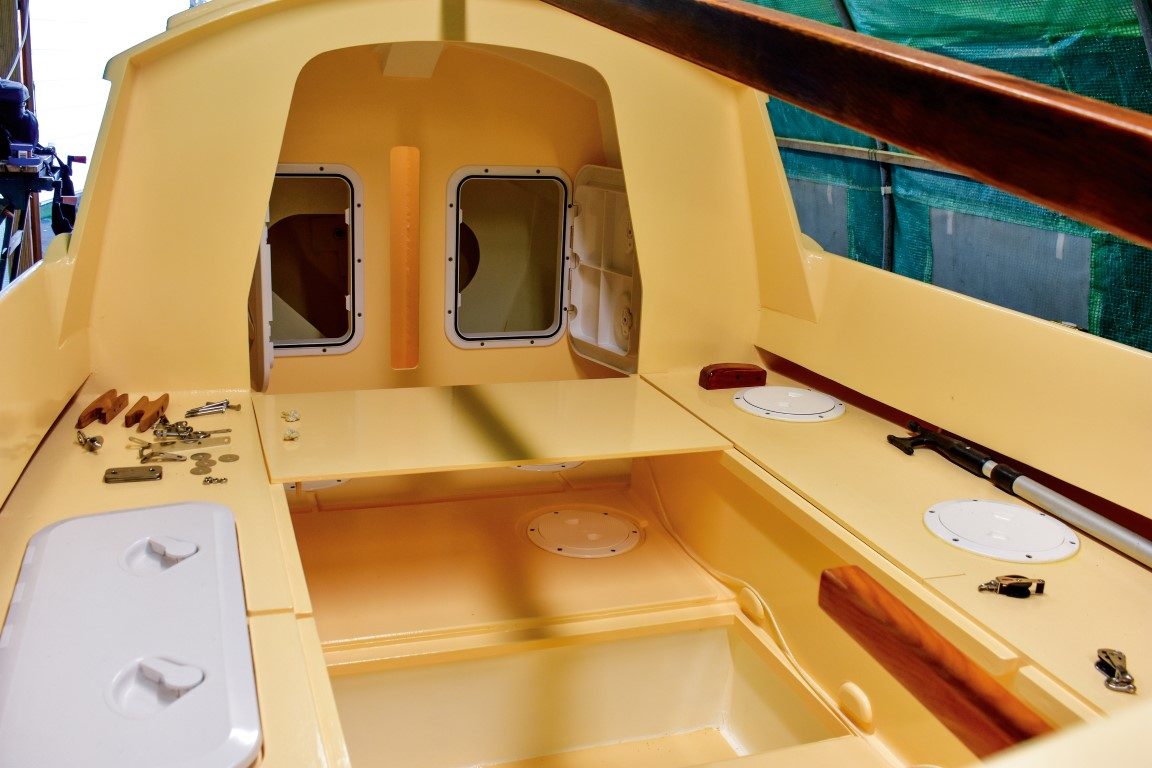
And the pram bow means that you don’t have to bend the planks and that allows the boat to have more beam.” The design, with perky sheerline and generous ends, has a beam of 1.63m.
The boats have a centreboard case offset to starboard under the cockpit seats which gives her a draft of 180mm with the board up and 765mm with it down. Sleeping in the cockpit, under a boom tent, there is one 1.9m berth and another 2.5m long.
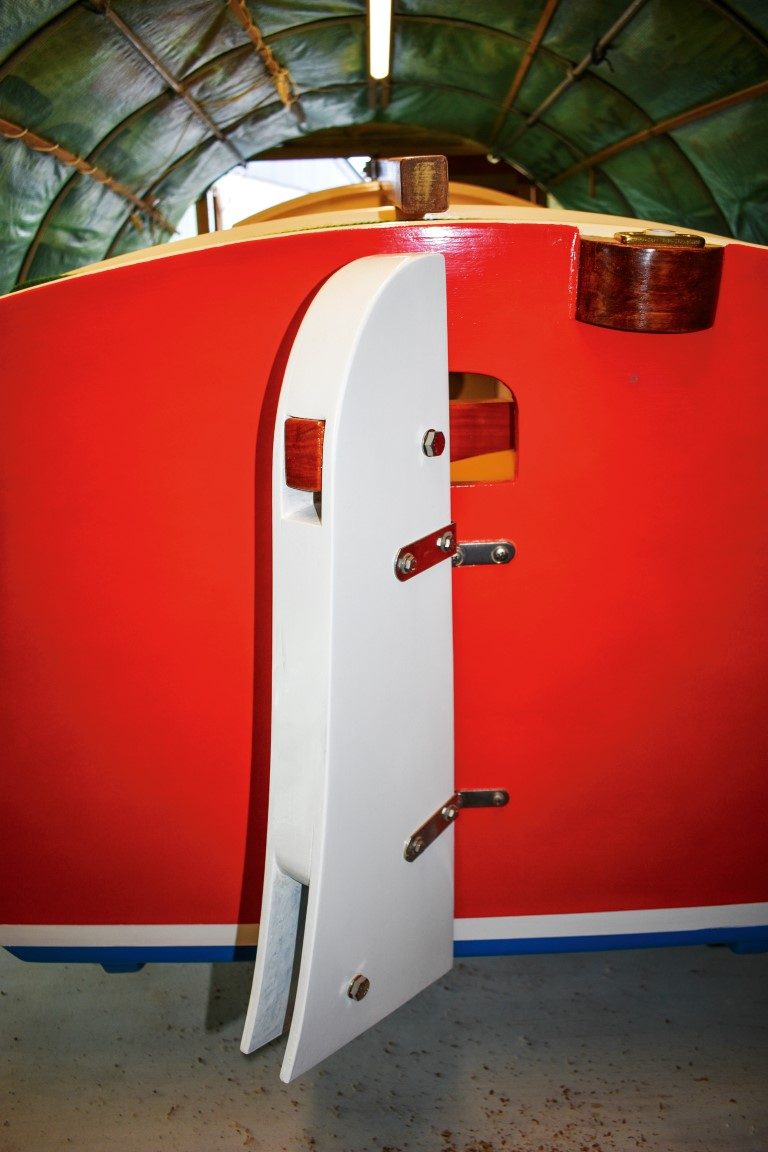
Steve’s called the new boat Red Dwarf and says he may vary the balanced lug rig on the plans with a gaff and topsail for a more traditional look. “The balanced lug is 9.3m2, so it’ll be interesting to see how it goes. That’s another beauty of a small boat – you can experiment without it costing a fortune.”
Five separate buoyancy tanks – one forward under the cuddy, two aft and two under the cockpit seats – make for a very stiff little boat and 77kg of water ballast can be added under the cockpit sole by undoing a bung in the bottom and topping the tank off by hand. With 78kg internal ballast added, she has a ballast:displacement ratio of about 40%.
Two small keels or runners are fitted to Red Dwarf’s flat bottom for beaching. “I just epoxied terylene webbing to them for abrasion,” says Steve. All up the hull weighs about 190kg.
The first fibreglass versions of the boat were built in the US in 2013 and DIY kits of CNC-cut plywood can be bought for $US2,800 ($NZ4,278) in that country.
Prospective owners can attend ‘SCAMP camps’ where they assemble their own kits in two weeks, overseen by boatbuilders and sometimes by John Welsford, and leave with hull and decks, ready for fitout.
“You just need basic carpentry tools – nothing flash,” Steve says. “I took two years to build Red Dwarf in my spare time, just mucking around in the evenings. Materials cost me about $5,500.”
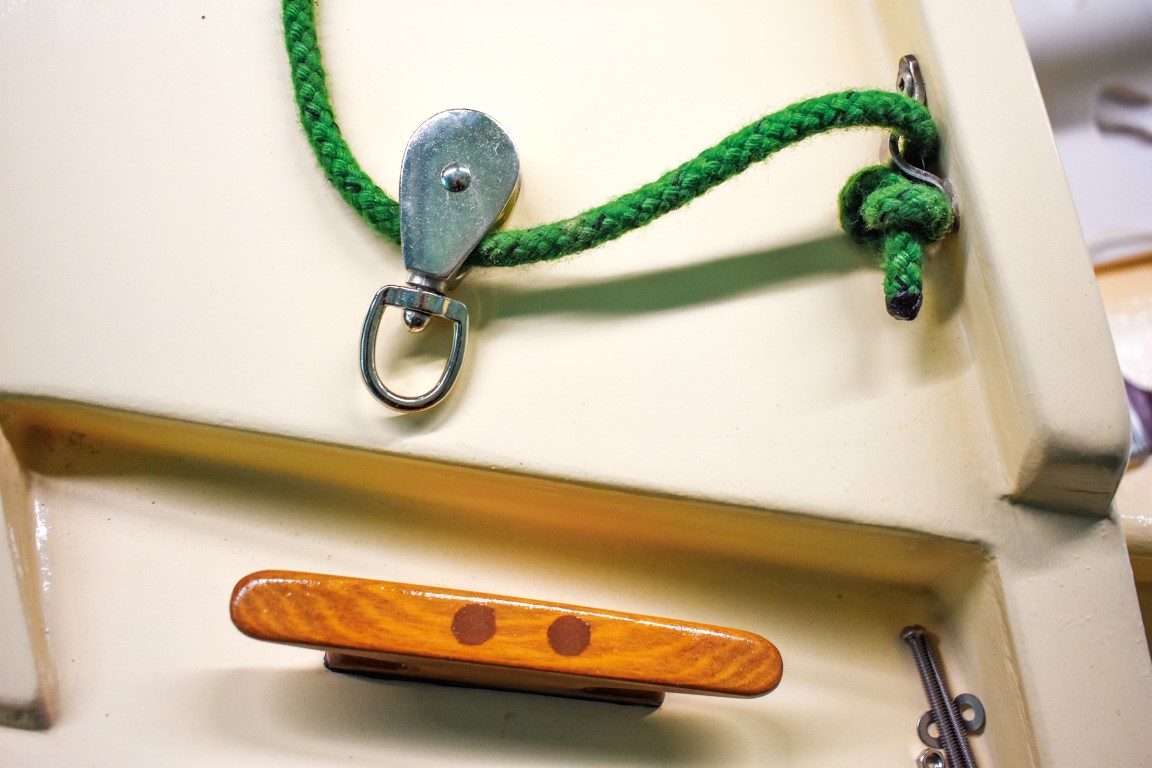
The little pocket cruising boats have already seen use well beyond their design brief – one has sailed the 750nm Port Townsend-to-Alaska race, another did the 300nm Everglades Challenge in Florida and, at time of writing, one is being strengthened for an attempt to be the smallest boat to round Cape Horn.
“Most decent four-cylinder cars can tow a SCAMP – that broadens your cruising potential a bit,” says Steve. The boats can be rowed and sculled, or have a bracket fitted for a small outboard.
According to John Welsford, SCAMP is all about “minimalism, efficiency and ease of use” or the maximum of fun, building and sailing, for minimal financial input.
All boxes ticked.
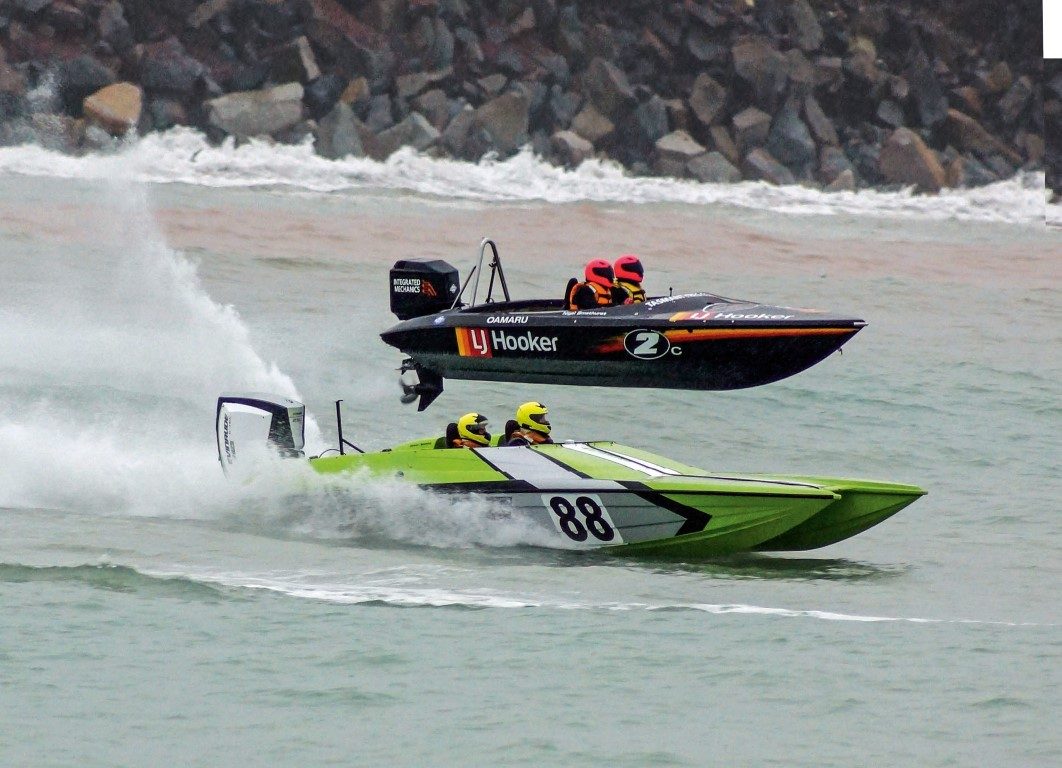
Power On : Keep trim

Ahoy! Fun free family activity abounds at Auckland Wooden Boat Festival
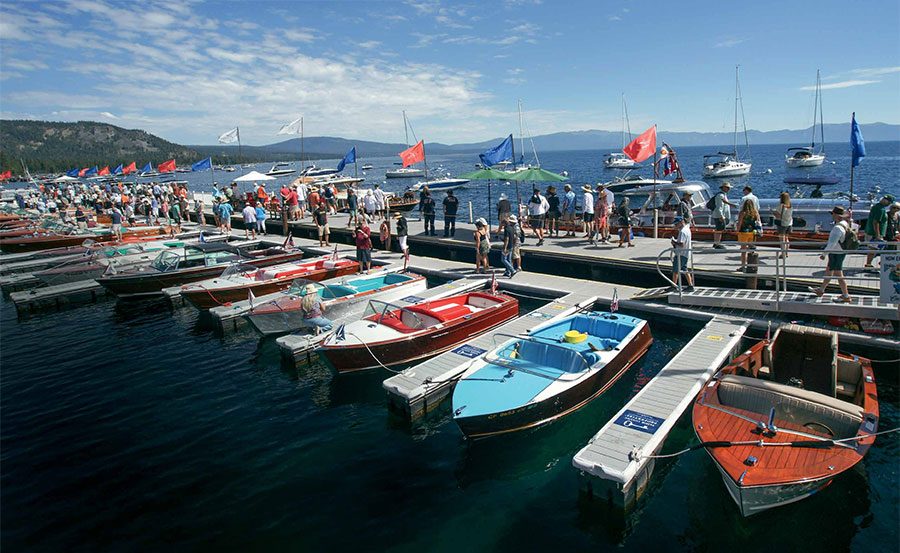
Lake Tahoe 50 years of elegance
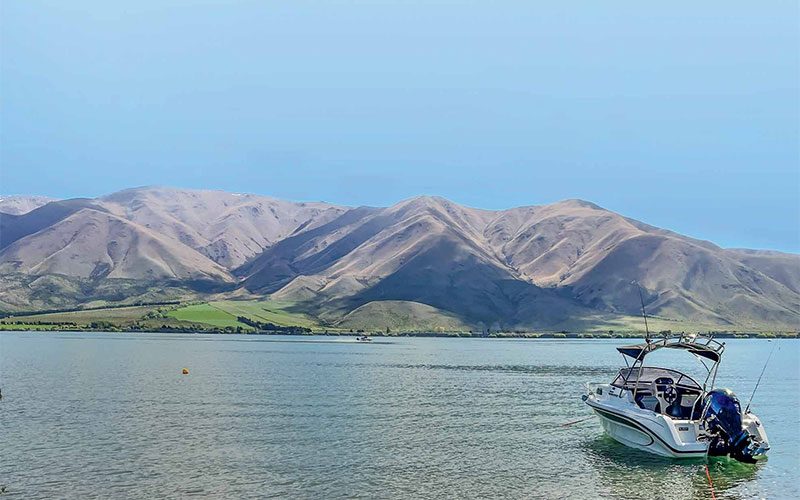
A walk on the wild side

- My Boats & Boat Articles
- Many types of Boatbuilding Plans
- Free Stitch and Glue Boat Plans
- Characteristics of Carbon Fiber
Steps in Building SCAMP
Here are the various steps I took to build my John Welsford SCAMP from Plans. The steps are not all in perfect chronological order because I would stop and work on a different part, then go back to what I was doing.
I build without assistance and some of my decisions and methods might not be the best or fastest. They work though. Because I work alone I have to find some ways of doing things that might take longer but can be safely accomplished by one person. I got help turning the boat though. The instruction manual is quite vague on many points and I hope future builders will find this boat building record useful.
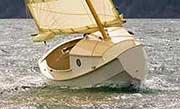
I try to be accurate and check my information, but mistakes happen.
- Skerry build
- Stitch & Glue Boatbuilding
- Free Boat Plans

Small Print
This information is for general knowledge and entertainment. It's not intended to replace plans or proper instructions. I'm not suggesting that was I did was the best way.

SmallCraftAdvisor.com
Small-Boat Related Message Board
Skip to content
- Subscriptions
- Back Issues
- Instant Downloads
- Boat Plans & Kits
- Message Board
- Classifieds
- Quick links
- Home Board index SCAMP
- It is currently Wed Mar 20, 2024 7:17 pm
- All times are UTC
Moderator: Moderator
- Jump to page:
- Announcements Replies Views Last post
- SCAMP Hardware and Rigging Kits @ Duckworks by Editors » Thu Sep 28, 2017 8:11 pm 0 Replies 42089 Views Last post by Editors Thu Sep 28, 2017 8:11 pm
- Scamp Kit Purchasing Information by Editors » Wed Nov 21, 2012 5:46 pm 5 Replies 64315 Views Last post by Editors Wed Apr 19, 2017 3:59 pm
- Topics Replies Views Last post
- Where to place cleats for fenders? by max » Fri Feb 09, 2024 1:48 am 2 Replies 96 Views Last post by dsimonson Mon Mar 11, 2024 9:18 pm
- 10 SCAMP Questions Pt 4 of 4 by ctbren » Mon Jan 08, 2024 12:09 am 2 Replies 908 Views Last post by dsimonson Sun Mar 10, 2024 9:18 pm
- 10 SCAMP Questions Pt 3 of 4 by ctbren » Mon Jan 08, 2024 12:06 am 2 Replies 716 Views Last post by dsimonson Sun Mar 10, 2024 9:02 pm
- 10 SCAMP Questions Pt 2 of 4 by ctbren » Mon Jan 08, 2024 12:03 am 2 Replies 756 Views Last post by dsimonson Sun Mar 10, 2024 8:37 pm
- 10 SCAMP Questions Pt1 of 4 by ctbren » Mon Jan 08, 2024 12:01 am 1 Replies 787 Views Last post by max Fri Feb 09, 2024 1:23 am
- Scallywag: What do you think? by jmc » Mon Oct 30, 2023 2:33 am 3 Replies 1976 Views Last post by Brent65 Sun Dec 31, 2023 6:59 pm
- Leak under starboard bench by Nemchono » Sun Aug 20, 2023 7:11 am 3 Replies 1810 Views Last post by DavidSW Tue Dec 19, 2023 5:18 pm
- Scamp needs a new wooden mast by Shackleton#268 » Sun Sep 03, 2023 12:14 am 2 Replies 1748 Views Last post by alienbogey Thu Nov 30, 2023 2:02 am
- Scamp for sale, Tennessee by Flyinb » Sat Jan 21, 2023 1:19 pm 2 Replies 2638 Views Last post by jmc Thu Nov 16, 2023 8:05 pm
- Gig Harbor Boatworks hull #1 for sale by Watermark » Tue Feb 11, 2020 5:26 pm 4 Replies 5631 Views Last post by Watermark Sat Nov 04, 2023 4:25 am
- Greetings to Scamp enthusiasts in New Zealand by CantabRob » Sun Jan 02, 2022 10:20 pm 2 Replies 2498 Views Last post by Scooby Wed Nov 01, 2023 8:30 am
- Is 420lbs dry weight? by Qapla » Thu Oct 05, 2023 4:28 pm 5 Replies 1644 Views Last post by GregWads Tue Oct 24, 2023 5:13 pm
- has the Scamp been assigned a Portsmouth handicap rating? by lhav » Tue Oct 17, 2023 10:58 pm 2 Replies 1432 Views Last post by wdscobie Thu Oct 19, 2023 12:21 pm
- sail cover ? by Bateau24 » Sun Jul 30, 2023 10:17 am 0 Replies 1452 Views Last post by Bateau24 Sun Jul 30, 2023 10:17 am
- GRP build from CNC by peterhull » Tue Jun 20, 2023 5:40 pm 1 Replies 1517 Views Last post by dsimonson Thu Jun 29, 2023 6:04 am
- Mooring by Jim MacDonald » Sat Mar 04, 2023 5:25 am 5 Replies 2106 Views Last post by dsimonson Thu Jun 29, 2023 5:00 am
- Vancouver area Scamps by Jim MacDonald » Sat Mar 04, 2023 6:57 pm 3 Replies 1865 Views Last post by dsimonson Thu Jun 29, 2023 4:01 am
- Scamp survey for WA state registration by Shackleton#268 » Fri Mar 10, 2023 7:17 pm 2 Replies 2245 Views Last post by ram Thu Jun 01, 2023 2:56 pm
- I need measurements for bulkhead for a repair (?) by DavidSW » Fri Apr 14, 2023 1:15 pm 3 Replies 2026 Views Last post by GregWads Wed May 17, 2023 5:23 pm
- bungee sail ties on the boom? by ElHeffe » Wed May 23, 2018 4:45 am 4 Replies 10122 Views Last post by Lachie88 Sat Apr 08, 2023 10:05 am
Return to Board Index
- Boat Building and Designs
- Small Boat Events and Gatherings
- Race to Alaska (R2AK)
- West Wight Potter
- Precision Sailboats
- ↳ News and Annoucements
- ↳ General Discussion
- Home Board index
Powered by phpBB ® Forum Software © phpBB Limited
Style by Arty - phpBB 3.3 by MrGaby
Privacy | Terms
Scamp Owners International
Join SOI | Login | Logout | Account
- View Forums (active tab)
- Unanswered topics
Support SOI
- 1985 Scamp 13 Layout 1
- 2021 Scamp 16 Layout 6 For Sale $24,500 Franklin, NC
- Toilet/shower pan wax ring (resolved)
- Rent or Borrow a 16' Scamp in Illinois
- 2024 June 21-23 Scamp Camp in Florence Oregon
- Problems with the 7-pin TV connection
New Comments
- So, I took the plunge! I 15 hours 20 min ago
- Any updates to this? Were you 2 weeks 2 days ago
- We had a cassette toilet in 3 weeks 1 day ago
- I've had to clean mine up 3 weeks 5 days ago
- Sway Bars are awesome 4 weeks 1 day ago
- Sway bars 4 weeks 1 day ago
- Should I order sway bars? 4 weeks 1 day ago
- Tightening contacts 1 month 1 day ago

- Plans & Kits
- Kits and Packages
- Qty in Cart

Scamp Foils Kit

SCAMP CNC PLYWOOD KIT
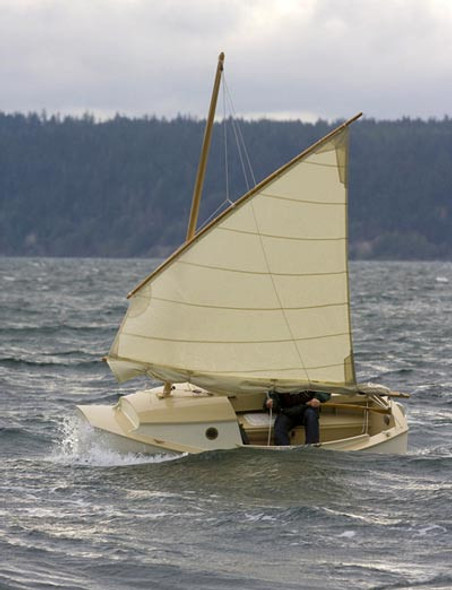
S.C.A.M.P. Plans Instant Download

Scamp Hardware

SCAMP Rigging Kits

Rudder Hardware for Scamp

S.C.A.M.P. Printed Plans

S.C.A.M.P. Sail
- Total: items /
- Add all to cart
Adding your products to cart

£ 4,375.00
What you get:
- 2 side seats
- Oars with collars and rowlocks
- Outboard bracket
- Rudder and tiller
- Daggerboard
- Gunter Sailing rig: consisting of mast, gaff, boom, 1 sail, mast stays, halyards and sheet*
- **NEW** – Lug Sailing rig now available as an alternative to the standard Gunter Rig: consisting of mast, spar, lug sail, halyard and sheet – further details below
- Buoyancy bags
*Notes: We are pleased to announce the return of the Lug Sailing rig. The cost of this rig is £300 less than the cost of the standard Gunter Sailing rig. Select box below to choose this option instead.
1. Choose Your Colour
This refers to the end panels at the bow and stern of the boat.
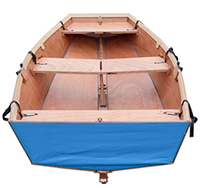
2. Choose Your Sail Colour
Pick the sail colour
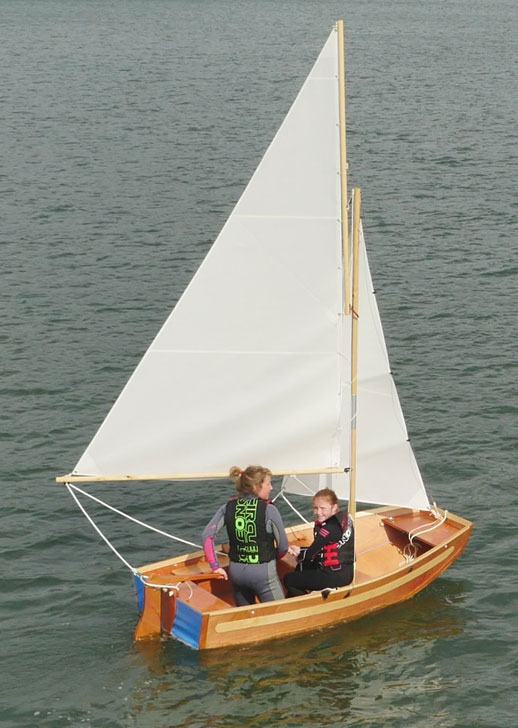
3. Now Add Your Optional Extras
- Dual Purpose Outboard Bracket
- Tiller Extension
- Standard Carry Bag
- Inflatable Roof Rack
- Window – Clear window (per sail)
- Unvarnished
- Lug Sailing Rig
- Rope Fender
- Pay Deposit
- Pay in Full
- Description
- Reviews (0)
- Timescale & Delivery
Seahopper Scamp Sail
Choose the Scamp for its compact size, ease of storage, good performance and light weight. If you genuinely need a boat that one person can carry with ease, and store easily this might be the choice for you. The Scamp is a truly portable boat easily loaded and off loaded from a roof rack or car top. Perfect as a yacht tender or an introduction to boating. And don’t forget you can buy the Scamp Row and upgrade later, if your budget is a little stretched.
Side seats are supplied with the motor and sail versions to allow the helmsman to sit further forward ensuring the boat rides level in the water. If you do go for the standard Gunter sailing version or upgrade to it you can sail the Scamp with the main alone. Have fun customising your boat with different sail colours and end panels! *Please note that the Scamp Sail is supplied with a main and jib, but the mast is stepped forward so that youcan sail with the main alone.
There are no reviews yet.
You must be logged in to post a review.
Delivery to the UK
Free delivery on all orders over £75!
Delivery for Seahopper Boats Seahopper boats have free delivery to the whole of the UK. Because all our boats are made to order there is a five week build time. We will notify you when your boat is ready to ship.
Delivery for Seahopper Accessories and Parts UK Mainland: Orders under £75 will have a £6.99 delivery charge. You should receive your order in 7-10 working days. Orders over £75 have free shipping. Scottish Highlands & UK Islands: Orders under £75 will have a delivery charge of £9.99. You should receive your order in 7-10 working days. Orders over £75 have free shipping.
We deliver Seahopper Boats all over the world. Click here for more details.
Related products

Lighter Row

Lighter Motor

Lighter Sail

Kondor Motor

IMAGES
VIDEO
COMMENTS
Exciting news that's been a long time coming . . . the Small Craft Advisor magazine released their first formal review of the SCAMP! For a bit of backstory, the SCAMP, which stands for Small Craft Advisor Magazine Project, was originally conceived by the magazine as a kit boat that would meet the needs of adventurous small craft sailors.It was designed by a team of passionate and ...
SCAMP is short, curvy, beamy, and high-sided, with a well-rockered flat bottom and a distinctive pram bow—a cross between a bulldog, a basketball, and an angry rubber duck. It's also one of the easiest-launching boats I've ever encountered. I barely had time to grab my gear before Ender had the boat rigged and ready: mast stepped, sail ...
The SCAMP is fun and easy to sail. They are a breeze from trailer to sailing, too. And, for daysailing, a SCAMP has more cockpit room. There is a boat review in a somewhat recent SCA comparing SCAMP, Montgomery 15, and WWP15, you'll want to read that. Top. Brent65 Major Contributor Posts: 292
The rest is history: More building plans and kits for SCAMP have been sold over the years than any other small cruising boat we can think of. Besides the original wooden version, Gig Harbor Boat Works was licensed in 2013 to produce a fiberglass SCAMP, and the little giant killer—in wood and fiberglass—has since its debut been at the center of various small-boat rallies, workshops and ...
The Scamp is a seaworthy 12′ sailboat that can handle a good dose of adventure. Just under 12 feet in length, Scamp boasts an unusual combination of features that give her the unique ability to explore waters too shallow for a larger boat, while retaining most of the bigger boat's comforts and capabilities. An offset centerboard opens up ...
Re: Questions for Scamp owners as I'm intrigued enough to as. by wdscobie » Thu Aug 27, 2015 5:32 pm. Gene: I believe that Gig Harbor Boatworks is bringing a fiberglass SCAMP to the Annapolis Sailboat show in October. You can give Dave a call at GHB to confirm - (253) 851-2126.
The Scamp is a seaworthy 12' sailboat that can handle a good dose of adventure. Just under 12 feet in length, Scamp boasts an unusual combination of features...
Official SCAMP Design Logo Burgee. $34.95. Sort by: Show: Our own youthful dreams often featured small boats in starring roles. Aboard these simple, stalwart little vessels we'd venture across nebulous bodies of water in search of distant wild shorelines or uncharted islands. We'd land, hike into the interior, and make camp.
Spencer gives everyone a run down of the SCAMP him and his buddy, Walter built. 🥬Become a Paid Subscriber and Help Us Out:https://www.thelitzenbergers.com/h...
The first fiberglass Scamp (built by Gig Harbor Boat Works) on its first big-water sea trial. Sailing speed got up to 6 knots! This 12' microcruiser contain...
SCAMP features an offset centerboard, massive flotation from sealed seats and stowage cabin, a water ballast tank holding 173 pounds of water, an after cabin "veranda" that functions like a hard dodger, and a flat bottom and skegs for beaching. PLANS: Complete plans now available on 7 24 x 36" sheets. A complete "Building guide" with suggested ...
Gig Harbor Boat Works, known for their strong, esthetically pleasing rowing boats, has already shipped a number of the new SCAMPS all over the country and overseas. ... 48 North Scamp Review . Newest Posts. Lobster Boat Redesign — Update #2; Mailbag: Family Diving from a 14′ Whitehall; New Year, New Digs! Save the Date: Seattle Boat Show ...
The SCAMP (acronym of Small Craft Advisor Magazine Project) is a wooden or fiberglass hulled Balanced Lug rigged sailing dinghy. The boat is 11 ft 11 in (3.63 m) long, and capable of accommodating four persons on a daysail or one to two for overnighting or extended cruising. Craig Wagner and Josh Colvin, editors of Small Craft Advisor Magazine ...
SCAMP has plenty of freeboard, lots of dry stowage, a self draining cockpit-and for safety's sake a huge amount of air-tank buoyancy. ... In describing the boat to John we said SCAMP would be so small that, "the designer himself might cringe a little when he puts the pencil down." Remarkably, where we expected John would need eleven or even ...
SCAMP is an acronym of the American Small Craft Advisor Magazine, a periodical published in Washington State, USA, with Project tacked on. Publishers Craig Wagner and Josh Colvin had sailed over 70 boats for the magazine and wanted a boat that was easy to build and shallow enough to go gunkholing in their Columbia River. ... Latest Boat Reviews ...
Installing the bow eye. Making the portholes/deadlights. Oar Socket Placement. Making the SCAMP mast. Turning SCAMP over. Sanding, marking waterline and Painting outside of hull. Finishing shaping the Bottom. Making the centreboard. Centreboard pivot and details.
A comprehensive boat building course from start to finish. The virtual or on line 2020 SCAMP Camp is your opportunity to build a very capable small boat at a remarkable savings with a master SCAMP builder and instructor at your side through every step. The cost savings are numerous when compared to the traditional SCAMP Camp model of builders ...
SCAMP Sailboat, Port Townsend, WA. 2,804 likes · 2 talking about this. LOA 11' 11" • Beam 5' 4" • Draft (up) 7" Water ballast 173 lb • Approx weight including rig 420 lbs
Groetjes, On these pages, I documented progress while building a SCAMP sailboat. My SCAMP sail# is 349, and she is called "ARGO". SCAMP is an acronym for Small Craft Advisor Magazine Project, and was conceived-of by the folks at that publication.It was designed by New Zealander John Welsford, and a photo of the finished boat along with a video of the first time I sailed her, may be found here ...
by DavidSW. Tue Dec 19, 2023 5:18 pm. Scamp needs a new wooden mast. by Shackleton#268 » Sun Sep 03, 2023 12:14 am. 2. 1744. by alienbogey. Thu Nov 30, 2023 2:02 am. Scamp for sale, Tennessee.
Share information on campgrounds - favorites, reviews, ones to avoid. Camping tips, stories, etc. this is the place to share your expertise or ask questions about how to Scamp! 70. 236. ISO curb parking... by Rubberduck. 07/16/2023 - 14:37. No new.
The SCAMP foils kit includes precision cut rudder and centerboard pre-shaped in halves cut from 18MM Okoume plywood. Save a lot of time and effort with these beautifully shaped foil blanks. ... Main-1002ft sail with 3 rows of reef points, bag, logo & ties included100 sq ft lugsail made exclusively by Neil Pryde Sails for SCAMP. This class sail ...
What you get:Boat3 seats2 side seatsOars with collars and rowlocksOutboard bracketRudder and tillerDaggerboardGunter Sailing rig: consisting of mast, gaff, boom, 1 sail, mast stays, halyards and sheet***NEW** - Lug Sailing rig now available as an alternative to the standard Gunter Rig: consisting of mast, spar, lug sail, halyard and sheet - further details belowBuoyancy bags*Notes: We are ...